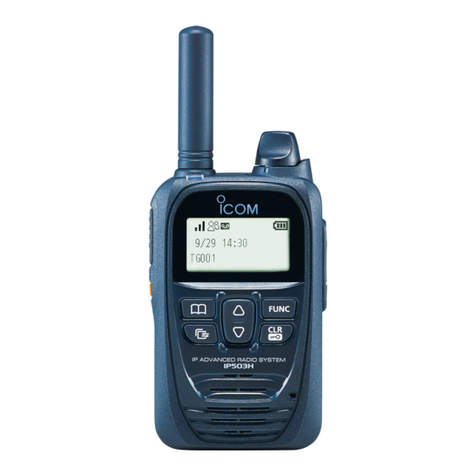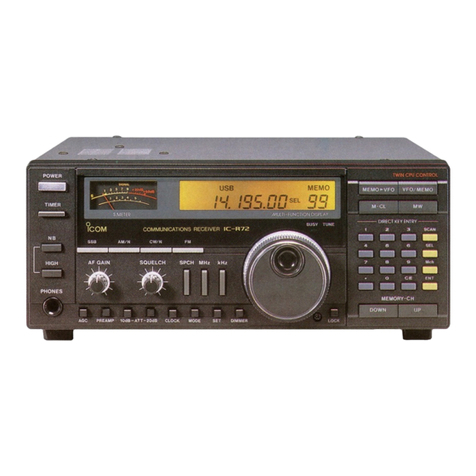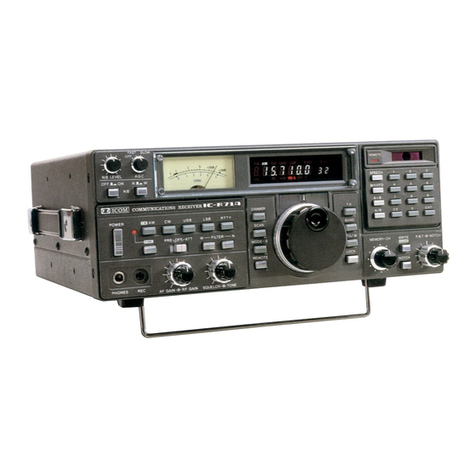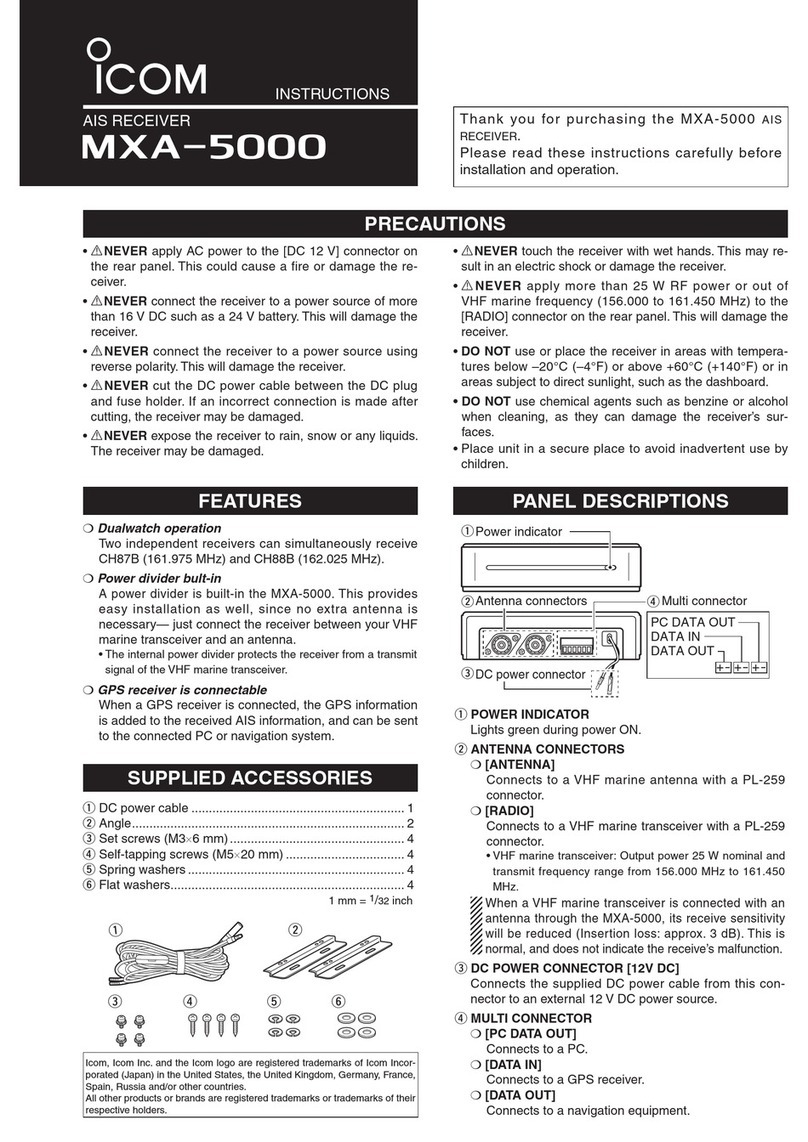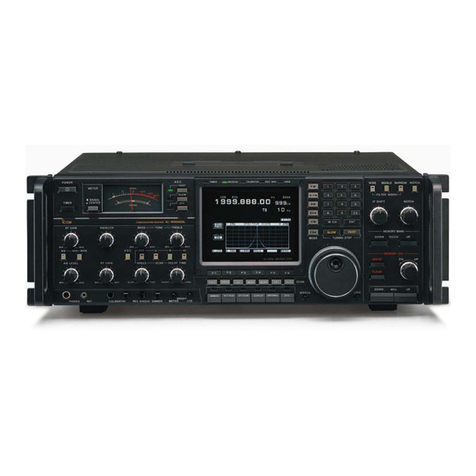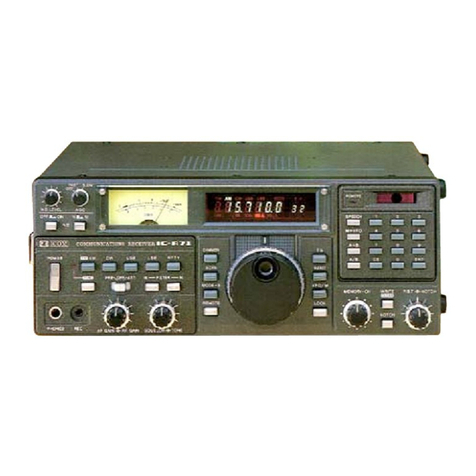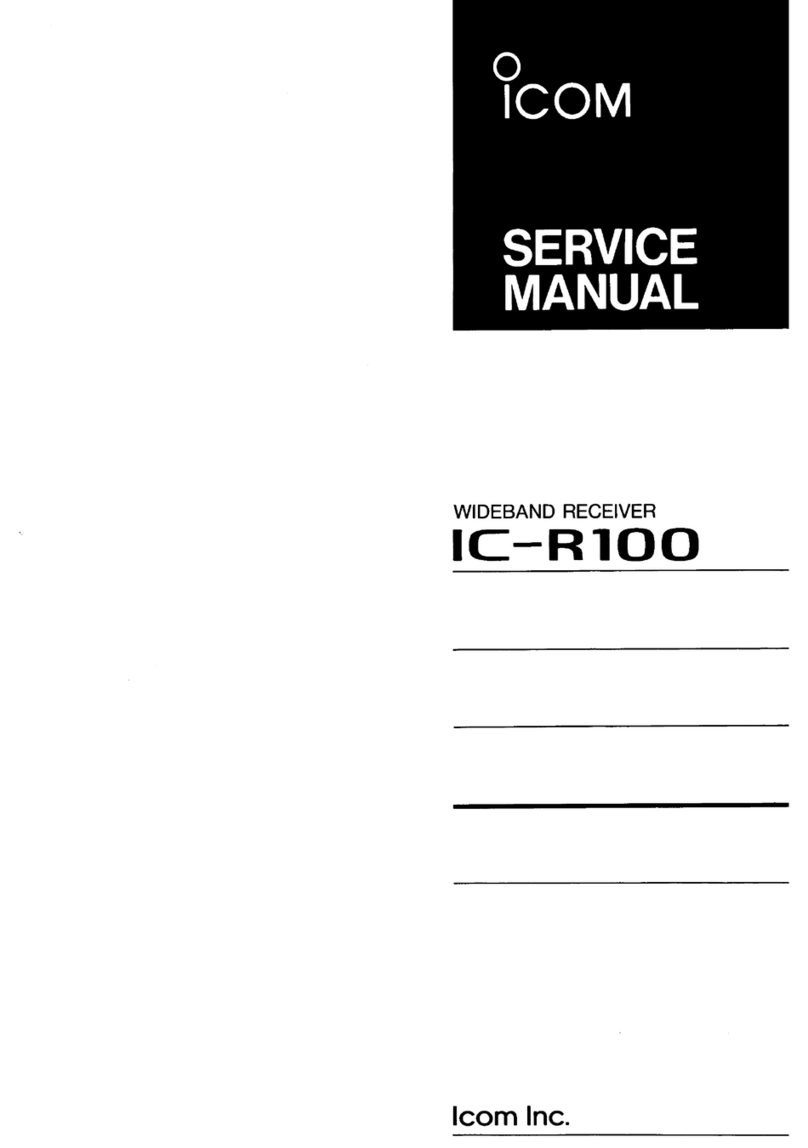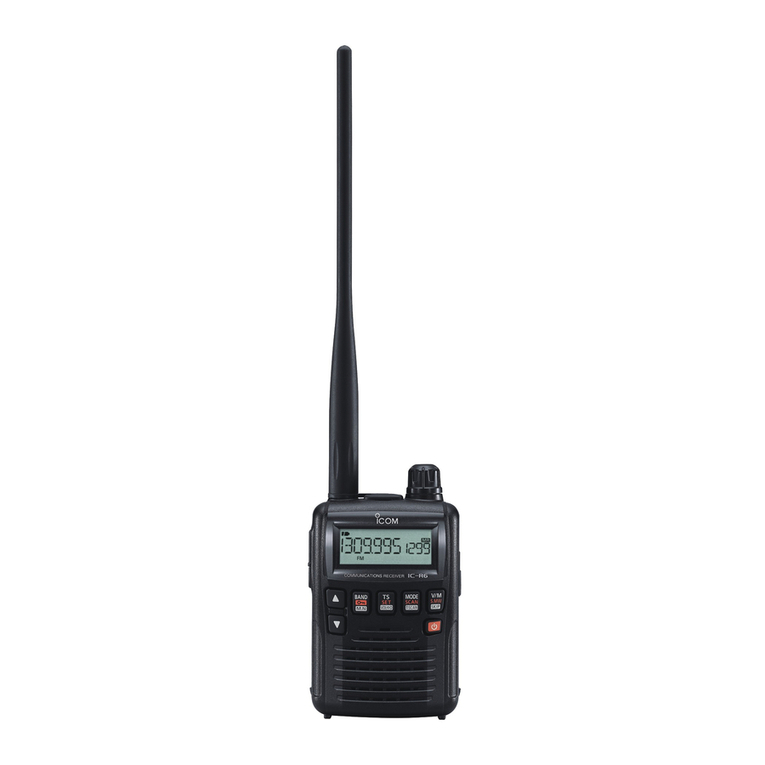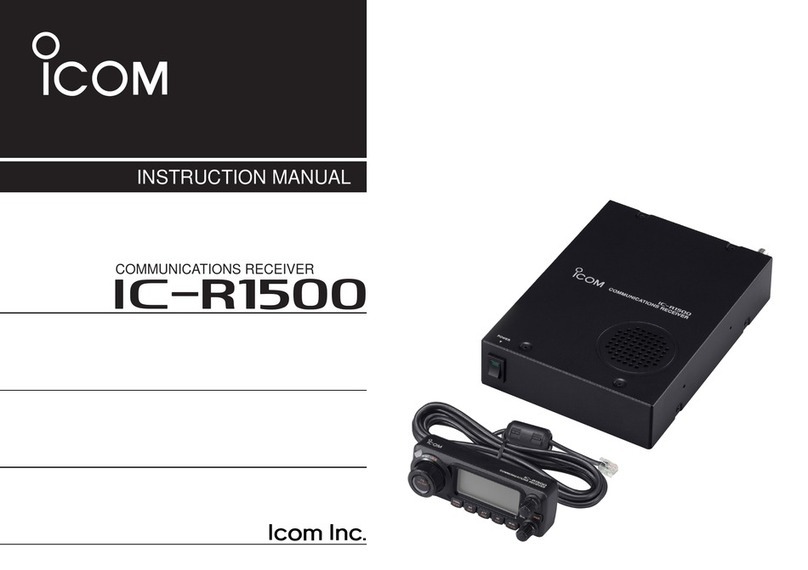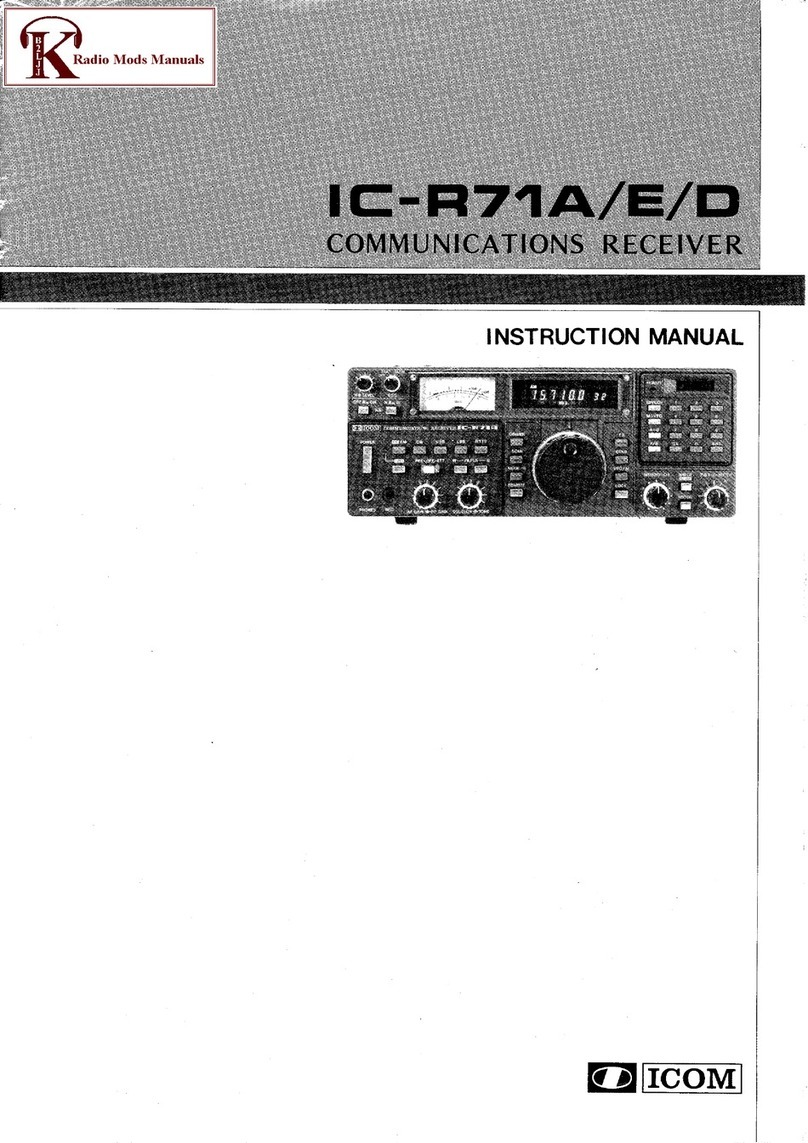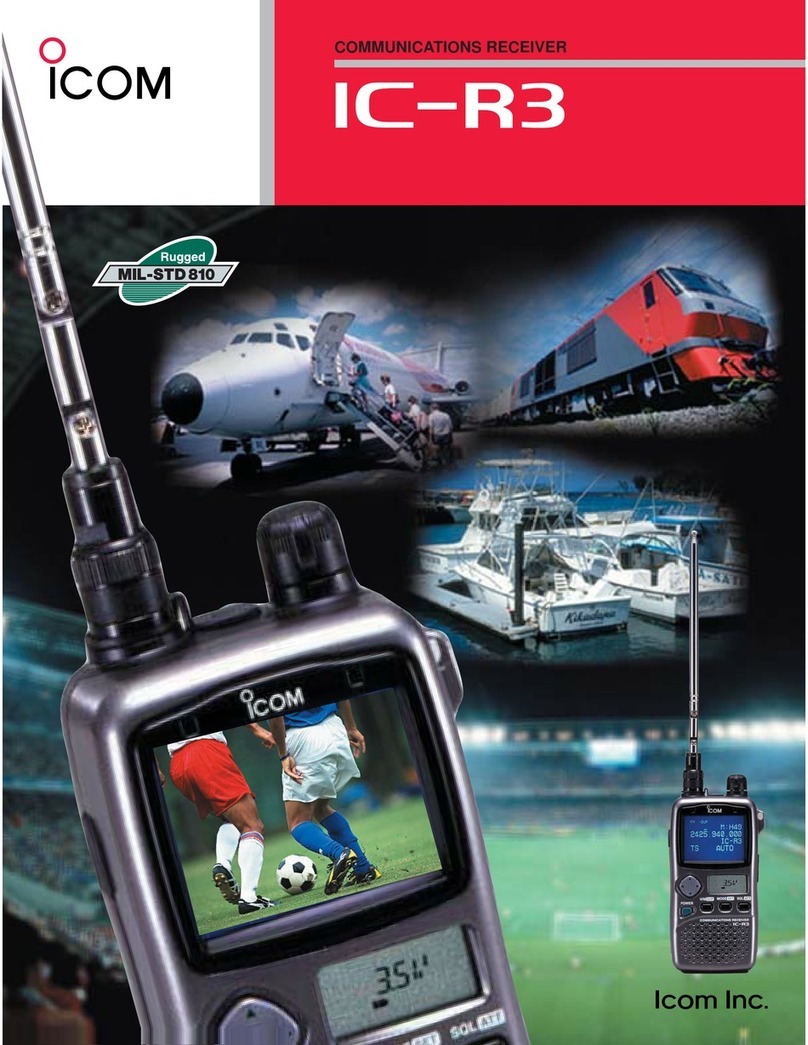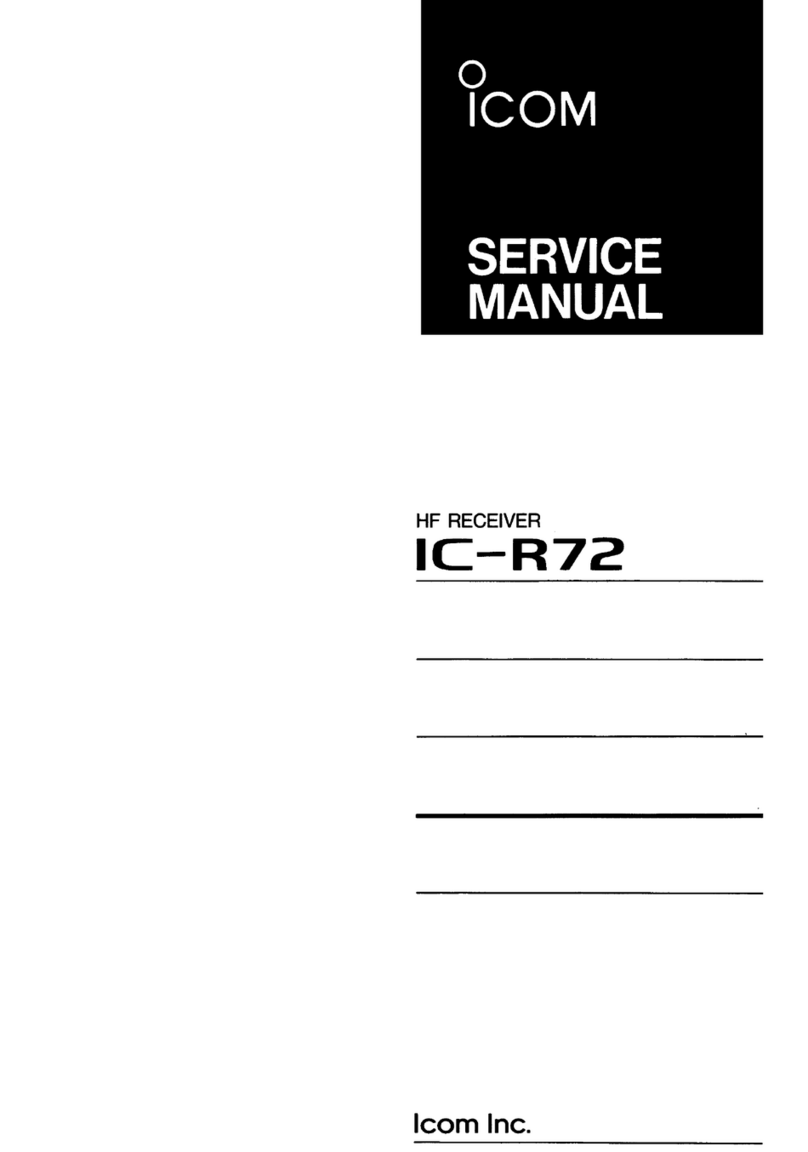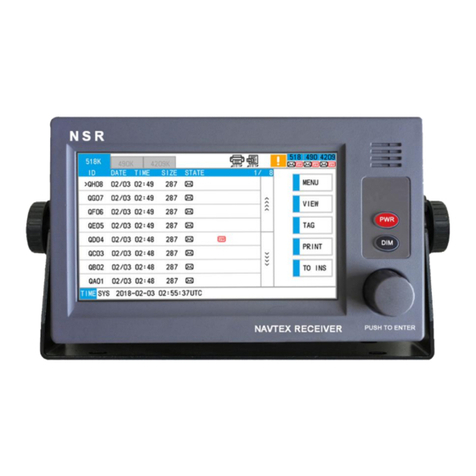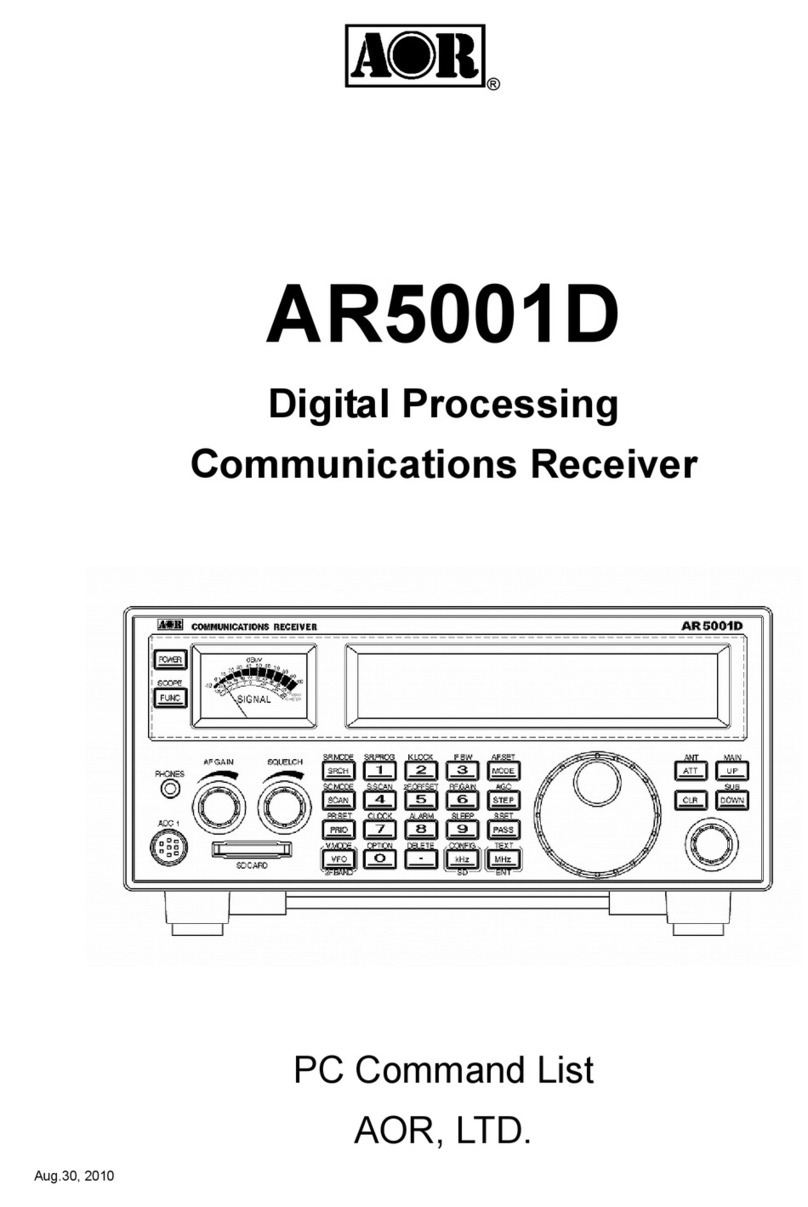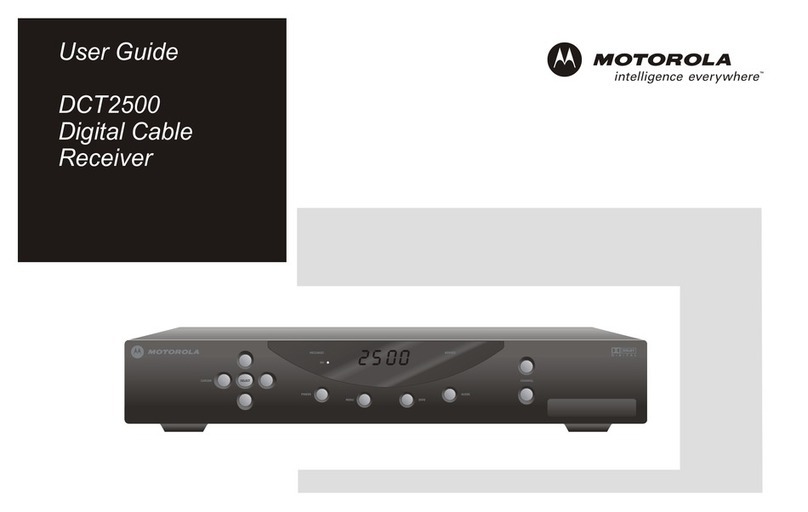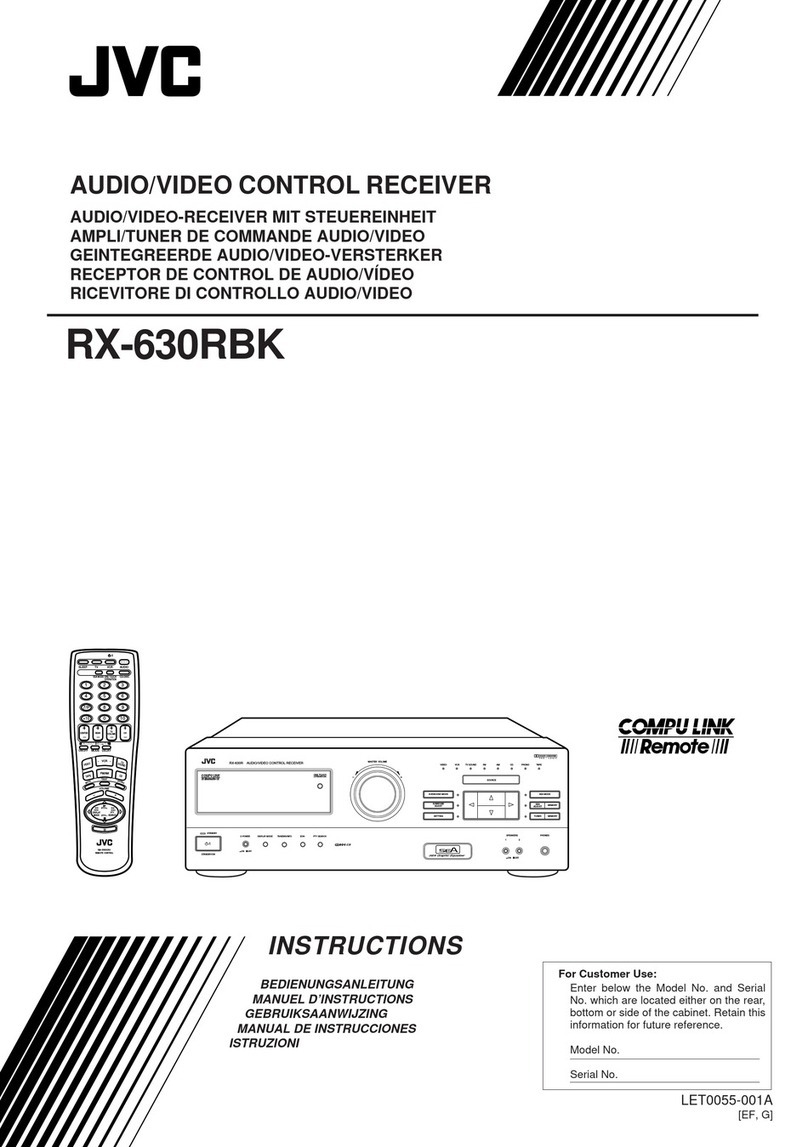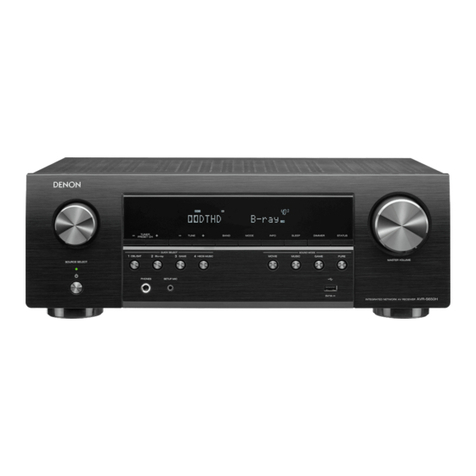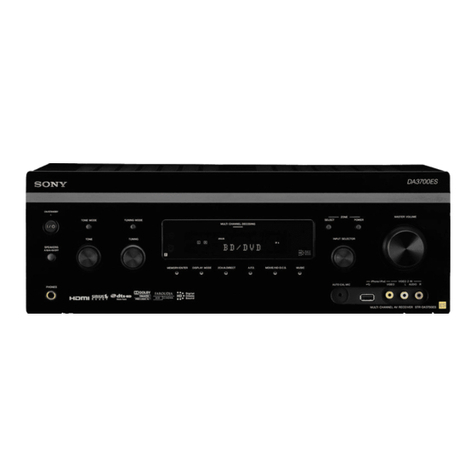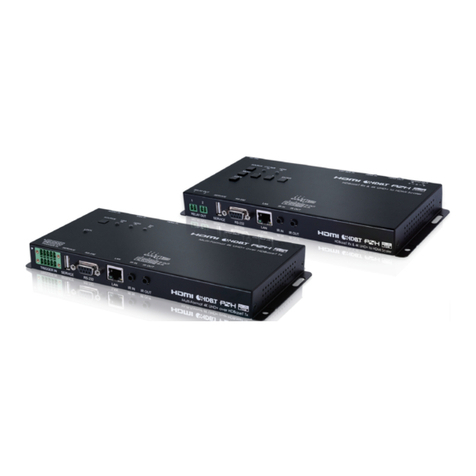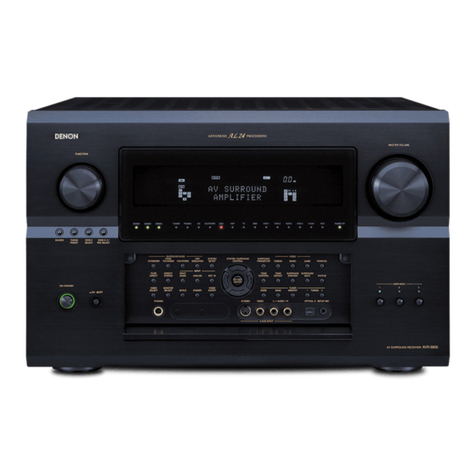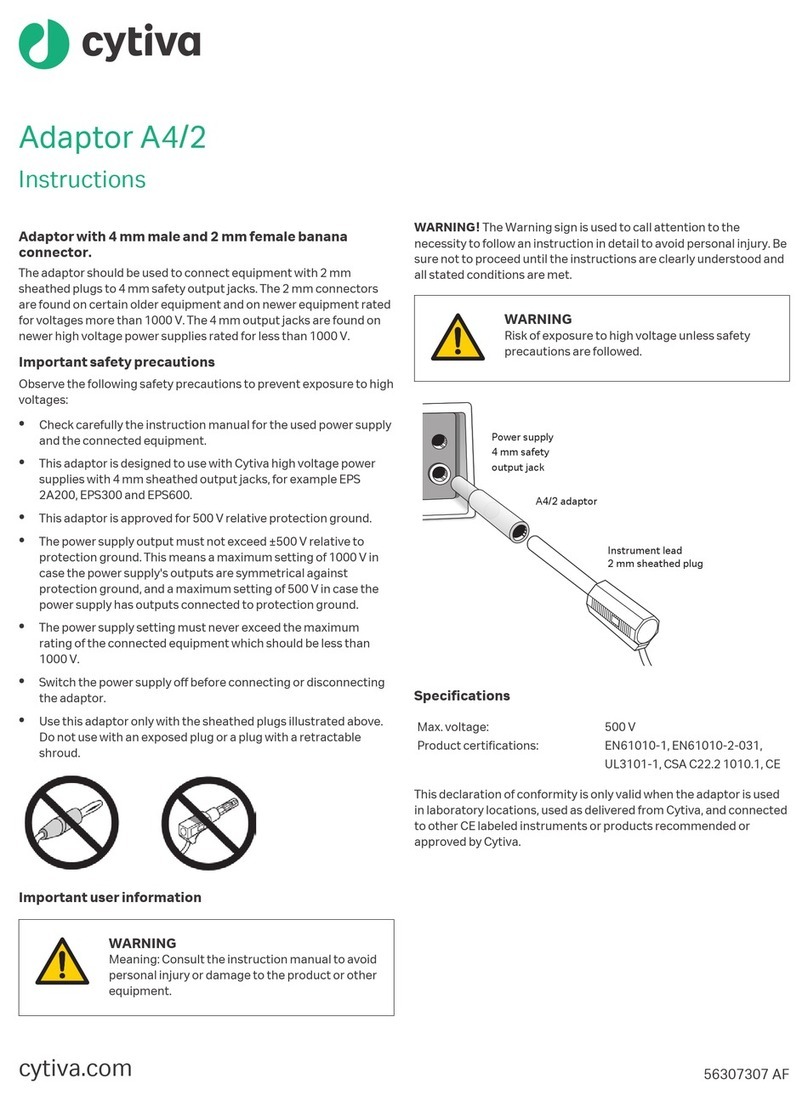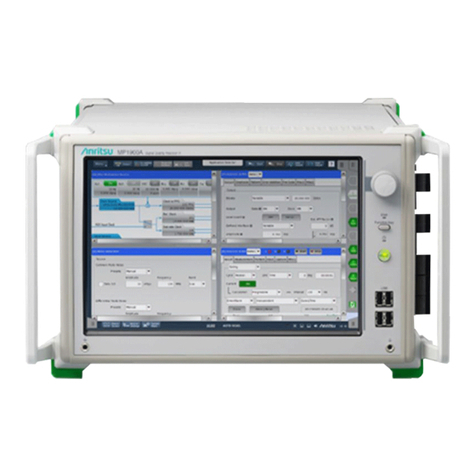Icom IC-R7100 User manual

WIDEBAND RECEIVER
IC
R7100
•
Icom
Inc.

INTRODUCTION
Thi
s service manual describes the latest service infor-
m
ation
tor
the
IC-R7100 WIDEBAND
RE
CEIVER at Ihe
ti
me
of
publ
ic
ation.
5verslons
of
th
eIC-R7100 have been desi
gn
ed. This
serv
ice
manual
co
vers each versten.
VE
RS
I
ON
NO
.VER
SION
SYM
BOL
#0
2U
.S
.A
. U
SA
#03
Europe
EUR
#04
Australia
AU
S
# 05 Germany F
RG
#06
Fran
ce
FRA
To upgrade quality, all electrical or mechanicaI parts
and internal circuits are subject to change without
notlee or obligat
io
n.
DANGER
Use
ONLY
the speeified AC voltage des
cr
ibed on Ihe
AC powersoeket. Other voltages wil! causa receiver
d
am
age or personal injury.
DO
NOT
louch Ihe
REG
UNIT after
Ihe
receiver is
connected to an AC eutlet.
An
insulated tooi must ba
used at all times.
DO
NOT
expose Ihe receiver to rain, snow or any liquids.
DO
NOT
apply an RF
signalo
f m
or
e than 100 mW
(20 dBm)to Ihe antenna connector. This could damage
Ihe receiver's front-end.
ORDERING PARTS
Be sure
10
include Ihe following four points when ordering
r
eplac
em
ent parts:
1. 1
Q·dig
it
ord
er numb
er
s
2. Component part nurnb
er
-and name
3. Equipment model name and
unit
name
4. Quantity re
cu
lr
ed
< SAMPLE
ORDER
>
111
0001
360
IC
~PC1
24
2H
te-
R7100
MA
1N
UNIT
5
pre
ces
881
0005
510
Screw FHM3
x6
ZKBS l
e-R
71
00Top
cov
er 10pieces
Addr
esses
ar
e prov
id
ed
on
Ihe
inside back cover tor your
con
venience.
.REPAIR NOTES
1. Make sure a probl
em
is internal
bet
ore disassembling
the receiver.
2.
DO
NOT
open the receiver until Ihe receiver is
disconnected trom a power source.
3.
USE
an exlernal AC power supply
10
areceiver power
source during lesling.
4. DO
NOT
force any
of
the variabie componenIs.Turn
Ihem slowly and sm
oo
thly.
5.
DO
NOT
short any circuits
or
eleclron
ic parts.
An
insula
te
d tuning 1001 MUST be used
lor
all adlust-
rnents.
6. DO
NOT
keep
pow
er ON tor a long
Iime
when the
receiver is detective.
7. READ
lh
einsturelions
of
lest equipmenl Ihoroughly
betore connecting equipm
enl
10 Ihe receiver.

SECTION
SECTION
SECTION
1
2
3
TABLE OF CONTENTS
SPECIFICATIONS ...................... 1- 1
INSIDE VIEWS.....................................
..
................. 2- 1- 2
ClRCUIT DESCRIPTION....
..
..
.
..
.
....
.
.. ..
. .
..
.
.. ..
..
.
..
.
..
..
. . . . . . . 3 - 1 - 13
3 . 1 RECEIVER CIRCUITS . . . . . . . . . . . . .
..
........................................ 3- 1
3·2
PLL CIRCUITS...................
..
......
..
...•............................ 3- 10
3·3
LOGIC CIRCUITS. . . . . .
..
. . .
..
.
..
. .
..
. .
....
.................................. 3- 12
SECTION 4
MECHANICAL
PARTS
AND
DISASSEMBLY. . _. . . . . . 4 - 1 - 6
4 . 1 FR
ONT
PANEL .
4 . 2
ACC
ES
SO
RIES
. . . .
..
...........
..
. . . . . .
..
......
..
. . .
..
.
..
. . . . •
..
..........
4 • 3 CHASSIS
UN
ITS .
4 - 4
REAR
PANEL
...
.. ..
. • . . . . . . . . . . . . . . . . .
..
.
•.
•.
..
. • .
......
.....
.....
. . . .
..
..
4-1
4-1
4 - 3
4-
S
SECTION 5PARTS LIST .. ........................................................ 5 - 1
.....
18
SECTION 6ADJUSTMENT PROCEDURES 6 - 1 - 10
6 . 1
6'2
6
·3
•
6·4
PREPARATION BEFORE SERVICING , .
PLL ADJUSTMENT .
LOCAL OSCILLATOR ADJUSTMENT .
RECEIVER ADJUSTMENT .
6
-1
6
-2
6
-2
6
-4
SECTION 7BOARD LAYOUTS , 7 - 1 - 15
7 . 1
7 · 2
7 - 3
7-4
7
-S
7 · 6
7 · 7
MAIN UNIT . . . . . . .
.•
. .
..
...
....
. . . . . . .
..
. . . . . . . . .
..
...........
..
....
..
....
AF
UNIT
..
. .
....
• . . .
..
....
..
.
..
..
. .
....
.........•.•.......
..
......
...
..
..
.
PLL UNIT .
CONV UNIT......•..•..
..
•. .
••.
.
..
.
..
.•.................
..
....
..
.......
..
.
•
LOG
IC
UNIT .
..
..............•...._........•.
...
..
.....
...
......
..
. . . . . . . .
R
EG
UNIT . . . • . .
....
..
. .
..
....
.•
.
..
. • • . . . . . . . . . . .
..
...............
..
......
DL
-RE
G
UNIT
. . . . .
..
.
..
....•
..
__
. . _ _ _ .
7 - 1
7-
2
7-S
7-
9
7
-1
1
7 - 14
7-1
S
SECTION
SECTION
8
9
BLOCK DIAGRAM ........................................................ 8- 1
VOLTAGE DIAGRAM
........
.
..
....
....
9
-1
- 2

• Us
abI
etemperature
range
• Frequeney stability (in FM mode) :
• Fr
eQu
ency coverage
• Mode
•Number of memo
ry
channe
ls
• Tuning step increments
•
An
te
nn
a impedance
• Power
su
p
ply
requ
ir
ement
• T
yp
e of an
ten
na
conn
ector
•Current drain (at 13.8 V
DG)
• D
im
ens
ion
s
• W
eight
• Rece
iv
e
sy
stem
•
In
termediate fr
equ
en
cies
• Sensitiv
ity
(typieal)
•Squeleh sensitivity (threshold)
• Selectiv
ity
•
Spur
l
ous
re
spon
se rejec
tion
•
Aud
io
output power
•
Audio
output impedance
•
•
•
•
•
•
•
•
VERSION FREOUENCY COVERAGE
U.SA
E
ur
ope
25.
0000
- 1999.9999 MHZ"
Austtaüa
Eranee 25
.0000-
87.5000 MHz
108.
0000
- 1999.9999 MHZ"
28
.0000-
29.7000 MHz
Germany 144.0000- 146.0000 MHz
4
30
.0000-
440.0000
MHz
1
240
.0000-1
300.0000
MHz
*Speelfleallons guaranteOO lor
25-1000
and 1
240-1300
MHz.
SSB (USB,
LSB
), AM (Normal, Narrow), WFM, FM (Normal, Narrow)
Memory
chann
e
ls
900
Scan
OOge
ehannels 20
0
.1
,1
,5
, 10, 12.5, 20, 25
,100
kHz, 1 MHz
50 0(Nominal)
117 V AC or 13.8 V
DC±
15 %(U.SA version)
240V AC or 13.8 V
DC±15
%(Europa, Australia and Franee verslons)
220 V AC (Germany version)
Type·N
Squelehed
1.
5 A
Max. audio
output
1.9 A
+10
'C- + 60 'C
(+14
' F- 140 ' F)
25-250
MHz Less than ± 1.5 kHz
250-1000
MHz Less than
±5
ppm
1240-1300
MHz Less than ± 10 ppm
(0 '
C-+
50 '
C;
+32
' F- + 122 oF)
241
(W) x 94 (H)x 239 (0)
mm
; 9.5 (W) x 3.7 (H)x 9.4 (
0)
in
(Pr
oj
ec
ti
o
ns
not
included)
6.0 kg (13.2 Ib)
SSB, AM, FM Triple-conversion superheterodyne system
WFM
Double
-c
on
vers
ion
su
pe
rheter
odyn
e
sy
stem
IF
25-
512 MHz 5
12-1
025
MHz
1st 778.700 MHz
266
.700
MHz
2nd 10.700 MHz 10.700
MHz
3rd'
455 kHz 455 kHz
*Exeept WFM (Crystal-eonverter system is adopted above 1025 MHz.)
SSB
Less than 0.2 IlV
lor
10 dB SIN
AM Less than 1.6
Il
Vtor 10 dB SIN
WFM Less than 1.0
Il
V tor 12 dB SINAO
FM Less than 0.35
Il
V
lor
12 dB SINAO
AM, FM Less tnan 0.35 IlV
SSB, WFM Less than 4.5 IlV
WFM
(1240-1300
MHz) Less than 6.0 IlV
SSB More than 2.4
kHz/-6
dB
AM, FM (Narrow)More than 6.0
kHz/-6
dB
FM, AM (Wide) More than 15 kHz/- 6 dB
WFM More than 150 kH
z/
- 6 dB
More than 50 dB
More than 2.0 W* wilh an 8 0load
·More Ihan 1.0 W in
FM
narrow
mode
4
-80
All
stated specificatlons are subject to
change
without
notice
or
obllgat
lon.
1 - 1

•CONV AND
REG
UNITS
HPF U
NIT--------
MIX IC
:------
--,.
(ICI : CB34
6MIB
)
Do
ubler
UNIT-------
•MAIN UNIT
3rd
mixer and 3rd
IF
clrcultsl----;
Na
l
ss
blanker
circult-------l
FM demodulator clrcu
lt-
-
---
WFM
demodulator
andl-----
WFM
AGC circuits
Regulalor
IC--------
(ICIO: NJM7809A)
AF power
ampllf
ler---
-
--
(IC9: uPC1242H)
•
CONV UNIT
••
2-1
REG
UNIT
c-
- - - - -
--
- Fuse
(F5: FGB 2A)
h----
-
----Tran
sf
ormer
[T2: TO·9)
----AC
po
we
r voltage
selec
ter
~-+--=
4-----
-
Tr a n s
f
o
r
m
er
(Tl :
Tp
-59 (GeneraI))
: Tp·60 (FRG)
----
-BFO
and SSB
demodulator circuits
'-----
5-meter squelch and
squetcn switch circuits
f-----Backup
battery for clock
(BT!: CR2032)
f----Backup
battery for memories
(BT2: CR2032)

• RF AND PLL UNITS
BPF1
circuit
(25
-90
MHz)I----------------,
BPF2 circu
it
190
-250
MHz
)'----------
BPF3 circuit (250
-512
MHz)'-------~
BPF4
circuit
(512
-1025
MHz)---~
RF
UNIT--------
BPF
centrel
circuit
------
TRAP
UNIT'--------
FIl2
UNIT--------
MI
X2
UNIT---
---=.----
Fll1
UNIT--------
MI
X1
UNIT
'--------
2-2
Pll
UNIT
-------VCO
UNIT
'------PLL
mixer circuit
------
P
DOUBl
UNIT

3·1
RECEIVER CIRCUITS
3·1·1
RF CONVERTER CIRCUIT
(CONV, DOUBLER AND HPF UNITS)
The RF
co
nverter circuit
co
uverts the
1025-1999
.9999
MHz RF siçnats
to
25-1024
.9999 MHz RF signais.
The amplified signal is
ap
p/ied to IC1 on the CONV UNIT
and is then mixed with RF signals coming trom ICt on the
HPF UNIT. The resulting 25- 1024.9999 MHz signais
are applied
to
the RF UNIT through J2.
3·1·2 ATTENUATOR CIRCUIT (RF UNIT)
The high-pass filter attenuates the image signals bel
ow
12
00
MHz and
pr
even
ts
1 GHz (7
dBm
) LO signaIs from
en
te
ring the antenna
co
nnector.
(2) 1025.0000
-1999.9999
MHz
RF signals trom the antenna
co
nnect
or
(J7) are appned
to a high·pass filter (strip fine. L3.
Cl
- C6) on the HPF
UNIT through the 1 GHz converter swi
tc
hing relay (RLt.
RL2).
(1
)
25
.0000
-1024.9999
MHz
RF signals
tr
om an antenna connector (J7) pass t
hr
ough
the 1 GHz converter swi
tc
hing relay (RL1, RL2) and
bypass Ihe RF converter circuit. The signals are applied
to the RF UNIT through J2.
02
RF UNIT
"TT
CONT f-
ICS ,0
12
trom
LOOIC UNIT
IC5 (
pi
n&4)
Tne attenua
tor
circuit attenua
les
Ihe signal strength 10
20
dB
to proteet Ihe RF amplifier trom distortion when
excessively strong signals
are
re
ce
ived.
I
CS
switches Ihe power souree of tne attenuator circuit
ON or OFF by using an
"A
TT" signal trom the LOGIC
UNIT. Q21
an
cDS2 p
ro
vide the converted and stabie
voltage
to
IC5.
When the
[ATT]
swi
tc
h is pushed, the CPU (
ICS.
pin
64) on the LOGIC UNIT outputs a " HIGH" signal. The
"HIGH" signaI is app/ied to !C5 (pin
11
) and activates the
attenu
ato
rcircuit (
R2
- R8).
The
fII
tered signals are
app
lied la the
atl
enuator circuit
(
R2-
R8) through a swi
tc
hing diode (D3).
ca
co
rn-
pens
ate
sfor attenuati
on
when high f
re
quencies are
receiv
ed
. The resulting signals are applied
to
the RF
circuit through a
sw
itc
hi
ng di
od
e (D4).
When the CPU
(I
CS,
pin 64) on the LOGIC UNIT out-
puts a " LO
W"
signal, Q12 and R10G
act
as an inverter.
The inver
te
r supp/ies a "THROUGH" signal to ICS (pin
10)
;
then, the filtered signals pass through a switchlng diode
(Dl ) and are
ap
pfied to the RF circuit through another
switching diode (02).
The 2
5-
1024.9999 MHz signals are app
/i
ed to a band·
pass filter (strip
fi
ne, L3, Cl - C6) to suppress out-ot-band
signaIs. The flltered signals either enter or bypass an
attenuat
or
circuit.
,
,
I
I
Cl
I
r-"
I-
~
6"
"-<
'i
'
J
1
OPF
(X
l,
t
Ll---L..J
11
024.9999MHz
ISIQM !
I
I
,
,
,
,
I
,
I
I
I
I
I
I
CONV
UNIT Fig. 1
500MH'
. 3
O.
166
.667MHz
.3
03
r-
~
0 "
1 55.555MHz
0 1
""'-
02
OU
"
"/
\
AMP '--r
-'
r----------,
L----o.
.......
~JIW
HPF RF
AMP
I
_ " IC I
1025
......
I
"..·....
....
'1
I
LHPF UNIT
----""'T-----;
I
DO
U
BLER
UNIT I
I I
, '
DOOMH'
,
,
..
I----f'-----'
, Q1 ,
I I
LJ
\V
A
55
.555 MHz reierenee signal is produced by an
oscillator circuit
(X
l ,
Ot)
and is then muitiplied by three
at L2 and L3.
Th
e resulting 166.666 MHz signaI is
a
mp
/ified at Q3 and is then multiplied by three at Q4.
The resulting 500 MHz (0 dBm) signal is doubied
to
produce a 1 GHz (7 dBm) LO sig
naion
the OOUBLER
UNIT.
•
RF
CONVERTER
AND
ATIENUATOR
CIRCUITS
The filter
ed
signaIs pass through a wide range RF
amplifier (IC
1)
to provide 20 dB gain over a wide-band
trequen
cv
range ano are then
ap
plled to a mixer
circu
it
(IC1) on the CONV UNIT. ICl employs a OBM (Double
Balanced Mixer). The signalsare mixed with the 1 GHz
LO signaI coming trom the OOUBLER UNIT.
3-1

3-1
-3 RF CIRCUIT (RF UNIT)
The RF
circ
uit ampUlies slgnals within the range
ol
Irequency coverage and filters out-ot-band signaIs.
The RF ampliliers
(al
-a4
) employ gallium arsenic
FIT
s
(35K121). The combinatIon ol the RF amplifiers and
tuned bandpass filters expand the dynamic range and
enhance the sensitivity tor the high frequency. Each
tuned amplifier has a
pp
roxi
ma
tely 10 dB gain.
06
......
0 10 employ varactor diodes which arecontrolled
by the PLL loek voltage. The voltage is
curr
ent-ampüüed
at the
OC
am
plil
ier circuit (IC3a, ICl a) and is then applied
to
the varactor diodes. These varactor diodes tune
the
ce
nter trequency of an RF passband tor wide bandwidth
receiving and 9000 image response rejection.
D50 prote
ct
sthe varactor diodes trom being charg
ed
over their maximum voltag
e.
1C4
lunetions
as a comparator and is
co
ntrolled by the
BPF4 signal line. Pin 1 of 1C4 outputs positive voltage
in a frequency range of 5
12-1024
.9999 MHz,
whiJ
e pin 7
of
1
C4
outputs positive voltage In a frequ
enc
y range of
25
.oooo-
51
10
9999 MHz.
IC5 switches the power source of
BPF1
- B
PF
4 ON
or OFF by using "Bl - B4" and "BH" signals from the
LOGI
CUNIT. 0 21 and
05
2
pro
vide the converted and
stabie voltage to
IC5
.
The 2
5-
1024.9999 MHz slgnals are applied to four
separate filters through switching diodes (
05
, 012, 019,
011, 0 18, 025) depending on the range of frequency
co
verage. The relay circuit (RL1,
RL
2) Is used instead
of switching diodes tor the
fr
equencies above 512 MHz.
This device prevents a diode trom causing distortien
wh
en r
ece
ivlng very strong signais.
(1) BPF1 (25.0000
-89
.9999 MHz)
The 25.oooo
-89
.9999 MHz signals pass through a parallel
resonant circuit (
06
, L
11
, C15) to suppress ha
lf
of the
reeeive freque
ncy
in
terfer
e
nce
signals
an
d are then
applied to an
RF
amplifier (
01)
via a tuned bandpass
filter (
07
, 08, L12
-L
14). The amplified signa!s are
applied to a 2nd RF amplifier (
07)
through a tuned band-
pass filter (Dg,
010
, L16
-L1S
).
(2) BPF2 (90.0000
-249.9999
MHz)
The 90
.0000-2
49.9999 MHz signals pass Ihrough a
parallel resonan,circuit(
013,
L22, C25)
to
suppress
half of the
recei
ve
freque
ncy
interference signaIs and are
the
nappli
ed
to a series resona
nt
circuit (0 14, L70, C6
1)
to suppress streng signals in a frequency ran
ge
of
BO-
110 MHz, sueh as FM and TV broadcasting stations.
The signals are applied to an RF amplifier (
02)
via a
tuned bandpass lilter (015, L23
-L2
5, C
11
9). The ampli-
li
ed signaIs are applied to a 2nd RF amplifier (07)
through another tuned bandpass filler (0
17,
L27-
L2
9,
C1
20).
013
-015
and 0 17 employ varactor diodes whlchare
controlled by the PLL lock voltage. The voltage is
current·amplified at lhe OC amplifier circuit (IC3a, ICl b)
and is then applied
to
the varac
tor
diodes. These varactor
diod
es tune the c
enter
Ir
equen
cy
of an
RF
passband
lor
w
id
eban
dw
idth reeeiving and
goOO
image response
re
jection
.
0
51
protect
s
varae
tor diodes
Ir
om being negatively
charged.
oRF CIRCUIT
10
FIL1
fFll 2
UN
I
_,
25.0000 89 9999MHz
-•
..
,.
1\
Ql
AF
"'""
I
~!
IICB Iomp
OB-
""!'
r-, i% I
r-,
I
~
•
34
II
l-;;.
«,III
L
__
.
__
.J
I178.1
....,
I
1291
.1MHz
BPFZ II
9O.
0000
-
2I
9.9999MHz
••Q' II
,DI1
LPF CONT I
'"~
LD
I
I
C3b
II
\~
OB
I
II
BPF
3cv lI
ne
L_
___
....J
trom
2SO
.0000-511.9999MHz VCO
UNIT
••
Q3
••
l
LD
p:(I
~
Uoe
024 'rom
P'
OOU
BL
UN
IT
N:1C
CONT
AGC
II
n.
0
20
'
rom
BPF
4
MAIN
UN
IT
512..
~
.9999M
HZ
\"'&0/
AF
UN
IT
.
PFCONT
CVllne
IC1,1C2 "
om
VCO
UN
IT
',om
ATT
clrcu
ll
FIg. 2
3-2

(3) BPF3 (250.0000
-511.9999
MHz)
The 250.0000
-5
11.9999 MHz signals pass through a
high-pass filter (L32, L69, C34, C35. C51, C133) to sup-
press the interference signaIs in low frequencies. The
filter cuts out the 240 MHz frequencies. The filtered
signals are applied to an
RF
amplifier
(a3
)via a tuned
bandpass filter (D21. D22, L33. L34). The amplified
signaIs are applied to a 2nd RF amplifier (
07
)through
another tuned bandpass filter (D23, D24, L36, L37).
D21
---D24 employ varactor diodes which are controlled
by the PLL Joek voltage. The voltaçe is current-amplified
at the DC amplifier circuit (IC3a. IC
2a
) and is then
appüed 10 Ihe varactor diodes. These varactor diodes
tuneIhe center frequency of an RF passband tor wide
bandwidth receiving and goed image response rejection.
(4) BPF4 (512.0000
-1024.9999
MHz)
RF relays are used instead of a diode swi
tc
hing system
tor signals above 512 MHz. To drive these relays, Q14
and
015
are used as current amplifiers.
The 512.0000
-10
24.9999 MHz signals pass through a
parallel resonant circuit (D26, L39, C45) to suppress half
of Ihe receive frequen
cy
interference signaIs and are
then a
pp
lied to an RF circuit (0 4) via a tuned bandpass
filter. The amplified signaIs are applied to a 2nd RF
amp
lifier (
07
)through a tuned bandpass filter. The tuned
bandpass filtersconsist of a strip line and 0 27
-03
0and
ensure stabie operation at high frequencies.
The voltage is current-amplified at the De amplifier circuit
(/C3a. IC3b) and is then applied to the varactor diode
s.
These varactor diodes tune the center frequency of an
RF
passband tor wide bandwidth receiving and goed image
response rejection.
The signaIs from the tuned notch
circu
it are applied to a
low-pass fiiter (strip line, C78, C82, C85. C89,
CI
3?) to
suppress high harmonie components
of
the 1st
LO
signa
!.
The filtered signals
are
applied to a 1st mixer circuit.
3·1·5 TUNED CONTROL CIRCUIT (RF UNIT)
The tuned control
cir
cuit
converts the PLL loek voltage to
tuned voltage tor the BPFI- BPF4 on the
RF
UNIT and
the tuned notch
circ
uit on the
TRAP
UNIT.
Fig. 3 shows the relation between the PLL loek voltage
and each tuned voltage. in the
BPF1
-BPF4
on the RF
UNIT and tuned notch
circu
it on the TRAP UNIT.
•PLL
LOeK
VOLTAGE AND TUNED VOLTAGE
D27
-0
30
employ varaetor diodes which are controlled
by the PLL loek voltage. The voltage is eurrent-amplified
at tne DC amplifier circuit (IC3a, IC2b) and is then applied
to the varactor diodes. These varactor diodes tune the
center frequeney
of
an RF passband for wide bandwidth
reeeiving and good image response re
je
ction.
(5)
2nd
RF AMPLIFIER
The 2nd RF amplifier (07) employs a wide frequency
band amplifier with approximately 10 dB gain.
The 25.0000
-1024
.9999 MHz signaIs from tour separate
filters are applied to the 2nd RF amplifier
(07
). The 2nd
RF amplifier has a feedback
cir
cu
it (L42, C67, R47) to
obtain stable gain in the wide frequency range. The
amplified signaIs are then applied 10 a tuned notch circuit.
3·1·4 TUNED NOTCH CIRCUIT (TRAP
UNIn
The
luned
notch
circu
il
prevents the 1st
Lü
signal from
enlering the antenna connector.
This circuit consists
of
a strip !ine and 031
-034
.The
noten frequency is adjusted to mateh the 1st
Lü
frequency
by
acontrol voltage coming from IC
3b
(pin
1)
.
D31--D
34 employ varaeter diodeswhich are eontrolled
by the PLL lock voltage.
The PLL lock voltage
(CV)
passes through the DC amplifier
(IC3a) to convert the impedance and Is then applied to
the operational amplifiers (ICl a, ICI b, IC2a, IC2b, IC3b).
Pin 1
of
ICI a supplies a tuned voltage to
BPF1
. R68
and R66 control the gain and offset voltage
of
ICl a
respeetively.
Pin 7
of
IC1b supplles atuned voitage to BPF2. D53
and R157 adjust the gain voltage
of
tCIb to fit the
characteristl
cs
of BPF2.
Pin 1
of
IC2a supplies a tuned voltage to BPF3.
•
3-3

Pin 7
ol
lC2b
supplies atuned voltage to BPF4.
Q9
and
010.
switch
Ihe
gain and ortset vollage
ol
IC2b ON or OFF
and convert the varlalions
of
2 PLL loek voltages lnto a
continuous tuned voltage.
Tabla 2 shows Ihe retatlon between receive frequency
and 1st IF Irequency.
Pin 1
ol
IC3b supplies aluned vollage to Ihe luned neten
clrcuil
on
Ihe
TRAP UNIT.
011 swilches Ihe offset voltage
ol
IC3b ON or OFF and
converts the variations
of
2
Pll
loek voltages into a
continuous luned voltage.
RECEIVE FREOUENCY [MHz] 1
et
IF FREOUENCY [MHz]
25-
89
.9999
778
.7 (FI1)
90-
249
.9999
778
.7
(Fll)
250-
511 .9999
778
.7 (FI1)
512
-1024.9999
266
.7 (FI2)
Tabl.2
Fig. 4 shows the
character
isties
of
the 1st IF filter.
3·1·6
1st
MIXER CIRCUIT (MIX1 UNIT)
'lST
IF
FILTER CHARACTERISTICS
I
I
I
I
I
I
I
I
I
I
'0.
Frequency
Fig. 4
I,
-21
.4
MHz
c
o
äi
"
;-
_co
->
<o!!
The
1st mixer circuit converts Ihe received
signailo
a
IIxed
Irequency
ol
the 1st IF signal
wilh
a PLL output
frequency. By changing the PLL frequency, only the
desired Irequency will pass Ihrough the
FIL1
UNIT or
FIL2 UNIT
al
the next stage
of
Ihe
1st mixer.
A778
.7-1291
.7 MHz (0 dBm)
lst
LO signal is applied
la
abandpass
111Ier
(strlp line. L78.
Cl34
. C59. C77.
C53-
C55) on tne
MIXl
UNIT to suppress unwanted signals
Ihrough
Pl
from Ihe PLL UNIT. The filtered slgnal is
amplified at Ihe 1st LO amplifiers
(05.
06). The 1
st
LO
amplifiers
(05,
06)
employ wide frequency band amplifiers
wlth approximalely 10
dB
gain and amplify the 1st LO
signaI
la
approxlmalely 10 dBm.
The
25.0000-1024.9999
MHz slgnals
are
mixed
al
ICS
with
Ihe
1st LO signal
la
produce a266.7 or 778.7 MHz
1st IF signal.
ICS
employs a DBM (Double Balanced
Mixer).
Tabla 1shows Ihe relation between receive frequency and
1sI LO frequency.
(1) FIL1
CIRCUIT
(25-511.9999
MHz)
The 778.7
MHz
1st IF signal
is
applied to an inductlve \
bandpass
li
lter
(Fll)
to suppressout-of-band signais.
Fll
sets
Ihe
center frequency at 778.7 MHz and covers a
5MHz bandwldlh. The fillered signal is applied to a noten
filter (L51. C79)
la
suppress
Ihe
image interference signal
(757.3 MHz).
RECEIVE FREOUENCY [MHz] 1
st
lO
FREOUENCY [MHz]
25
-
89
.9999
803
.7
-
868
.6999
90-
249
.9999
868
.7
-1028
.6999
2
50
- 511
.9999
1
02
8.7- 1
290
.6
999
512-1024
.9999
778.7-1291.6999
roble 1
3·1·7 1
st
IF
CIRCUIT
(RF, FIL1AND FIL2 UNITS)
(2)
FIL2
CIRCUIT
(512-1024.9999
MHz)
The 266.7 MHz 1st IF slgnal Is applied
la
ahelical
lilter
(L46. L47) to suppress out-of-band signa
ls
Ihrough
a series resonant circu
it
(L73.C66). The helical filler
sets the
center
frequency at 266.7 MHz and covers a
5MHz
bandw
ldlh
. The filtered slgnal passes Ihrough a
nolch
fliler (L67. L68.
CS8)
la
suppress
Ihe
image inler·
ference slgnal (245.3 MHz) and is then applied to series
resonant clrcults (L74. C90). The series resonant circuits
atlenuate out-ot-band signais.
The 1st IF signal (226.7
or
778.7 MHz) Is applied to a
1
st
IF
amp
lilier
(08)
providing approxlmalely 10 dB gain
over
a wideband frequency range.The 1st IF amplifier
emp
loys afeedback circuit (L43. C72. R56)
la
oblain
stabie gain in
Ihe
wlde Irequency range. The 2nd IF
slgnal is applied
10
t\Yo separate filters depending on
Ihe
receive frequency.
The 266.7
or
778.7 MHz 1st IF signal Is applied
la
alow-
pass filter (str
ip
line.
C139-C141)
la
suppress tne high
harmonie components
on
t
he
RF UNIT.
3-4

3·1·8 2nd MIXER CIRCUIT (MIX2 UNIT)
The 2nd mixer circuit converts Ihe 1
st
IF
signal
to a
2nd
IF signa
I.
A256 or 768 MHz (0 dBm) 2nd LO signaI is applied 10 a
1 GHz cutott
lew
-pass filter (strip line,
Cl04,
C105, C146)
on the MIX2 UNIT 10 suppress
Ihe
high harmonie com-
ponents through P3 from the PLL UNIT.
The filtered signal is ampllfied
al
Ihe 2nd LO amplifiers
(016
, Q17). The 2nd LO amplifiers (Q16,
017)
employ
wide frequency band amplifiers with approximately 10 JB
gain and amplify Ihe 2nd LO signal to approximately 10
dBm
. The amplified signal is applled 10 an attenuator
circuit (R116, R118).
3·1·9 AGC BUFFER AMPLIFIER CIRCUIT
(RF UNIT)
The AGC voltage shifts from approximately 4V 10 0V.
The AGC buffer amplifier (020) shifts approximalely 1.5 V
to
the minus voltage thaI
Ihe
RF amplifiers
(01-04)
require
.
3·1·10 2nd
IF
CIRCUIT (RF AND MAIN UNITS)
The 10.7 MHz 2nd IF signal is applled 10 a low-pass filter
which
cuts off Ihe frequencies around 400 MHz.
The
filter consists of a strip line and C142
-C144
and
prevents Ihe
high
harmoniecomponents
from
entering
tne 2nd mixer (IC7) on Ihe MIX2 UNIT_
The 266.7 or 778.7 MHz 1sI IF signal is mixed
al
IC7 wlth
the 2nd LO signaI to produce a
10_7
MHz 2nd IF signal.
The 10.7
MHz
2nd
fF signaI is output trom IC? (pin 1) and
is Ihen applled 10 Ihe RF UNIT_
IC7
employs a
OBM
(Double Balanced Mixer).
Tabla 3 shows Ihe relation between reeerve frequency
and 2nd LO Irequency.
The filtered signaIpassesIhrough a2nd IF amplifier (018)
wilh
approximalely 20 dB gain and is Ihen applled to the
MAIN UNIT Ihrough J4.
Aportion
of
Ihe
2nd IF signal output from IC7 passes
through abuffer-amplifier (019) and is then applied to a
20 MHz cutoft low-pass filler (L60,
Cl14
-C116
).
The
fillered
signal is applied 10 Ihe [IF
OUn
jack on the rear
panel.
RECEIVE
FREOUENCY [MHz]
2nd
LO FREOUENCY [MHz]
25-
89.9999 768
90- 249.9999 768
250-511.9999 768
512
-10
24.9999 256
Tabla 3
In WFM mode,
lhe
10.7 MHz 2nd IF signal passes Ihrough
Ihe
IF amplltiers (1.1,
055)
and is then applied to a high·
quality
eerarme
filler
(Fll)
coverlng the 230 kHz (3 dB)
bandwidth. The filtered signal is amplified
al
014
and
is then re-amplifled at
iCl1
.
014
and
IC11
provide
appro
xlmately 40 dB gain in WFM mode. The ampllfied
signal passes through another hiqh-quallty ceramlc filter
(F12)
covering the 230 kHz (3 dB) bandwidth and is Ihen
applied 10 Ihe WFM demodulalor circuit.
•
IF
CIRCUIT
In other modes, the 10.7 MHz 2nd IF signaI is applied 10
apair
of
crystal
filters (FI3) covering a
±7
.5 kHz (3 dB)
bandwidth
in
order to
obtain
wide selectIon capability
and to pass only desired signaIs. The
fil1ered
signal
is
applied 10 021.
FILZ
UNIT
MAIN UNIT
I.
r----I<f--
WFM
circuit
I.
'----I<f--FM
.AM
.SS8
circuit
I
I
I
I
I
I
I
I
I
I
I
AGC I
IIM
I
I
l~
I
MAIN UNIT I
I
I
I
I
'""
LO
IIM
r-;;';;;-;;;;;-l
IIC7 I
I •
10
.7~z
I X •
I I
I768MHZ I
I
~
I
I2!>6MHz I
I
,.dLO
I
I/
\
~
017
1
L_I-
__
...J
Fit
/
7787Mz
(RX
IntQ :2S
......
S11
.9999MHz)
r-------...,
I
I
I I
I I
r--------...,
I"
.lM"'
I
I\ F' / I
I I
L
__
~~~:
__
J
(RX IreQ :S1
2-
1024.9999MHz)
RF
UNIT
,,~
pu. UNIT Buller
r:
L......1
V
>-
-
---+
0'9
IIF
OUT)
JACK
Fig. 5
3-5

3·1·11 NOISE BLANKER CIRCUIT
(MAJN
UNIT)
The noise blanker circ
ui
t effec
tive
ly reduces
in
terference
trom pulse-type norse sucn as car
ign
it
ion
systems and
functions in only SSB and AM modes.
A
port
ion of the
2n
d IF signal output (drain
of
021)
Is
appli
ed
10
the noise
amp
lifier (IC14) and is then detected
at
the noise
detector
circuit
(046,
047
). The detected
voltage is applied
to
a noise blanker switch (027).
The threshold level of lhe noise blanker swi
tc
h
(027)
is
set at approximately 0.3 Vhigher than thaI of 0
26
to
avoid malfunctions when the operating frequency or mode
is
changed. When the detecled voltage exceeds the
tnresnold level, Q
28
output
s a blanki
ng
siçnal to activate
the
no
ise blanker
gate
circuit (030- 0 32).
Aportion of the detected voltage
is
a
pp
lie
d la a nolse
bianker AGC circuit
(026)
. The
Ihr
eshold level of the
no
ise blanker AGC circuit (026) is set at 0.6 V. The
nolse components are led back
la
the norse amplifier
(IC14) throu
gh
a
OC
amplifier (0 25). The time constant
of the naise blanker
AGC
circuit is determ
in
ed by R206.
R209 and C129. This AGC circuit does not det
ect
putse-
type norse.
The filter
ed
signal is
ap
plied to the 3rd IF amplifier circuit
(022
.
023)
and is then applied
10
the demodulator circuits,
3·1·13 WFM DEMODULATOR CIRCUIT
(MAIN UNIT)
The 10.7 MHz 2nd IF signal output from FI2 is applied to
pin 1 of IC12
to
demodula
te
tne
2nd IF signaI into an AF
signa!.
IC12 contains a
li
miter amplifier, a filter, an FM detector
and asignal meter circ
ui
t.
Input signaIfrom IC12 (pin 1) passes the limiter amplif
ier
an
d the filter sections
of
IC12.
Tha
filtered signal is
demodulated into an AF signa! by using the FM detect
or
sect
ion
of
IC1
2and the other components
(Xl,
L2
.R128,
C72. C73. 026).
A varactor diode (
026)
adjusts the distortion of the center
frequency in a
ce
ramic discriminator (X
l)
by changing its
voltage.
The AF signal is output from
IC1
2 (pin 6) and is then
applied
to
the buff
er
amplifier (016) for AF signaI switching
and
AF
signal level adjustment in other modes.
WF
M9
•
WFM
DEMODULATOR CIRCUIT
046
turns Ihe noise blanker
circuit
ON or OFF. While
pulse-type signals a
re
received, Q46 tu
rn
s Q28 ON.
Therefore. tne naise blanker gate circuit (0
30-
D32) is
r
ever
se·bias
ed
to cut
OFF
the 2nd IF signa!.
3-1
-12 3rd MIXER AND 3rd
IF
CIRCUITS
(MAIN UNIT)
The
3rd
mixer circuit couverts the 2nd IF signal
to
a 3rd
IF signal
wit
h the 3rd LO signal.
The
signal output from the noise blanker gate circuit
(
03
0- 032) enters the
3rd
mixer
circu
it (IC13). IC13 is
a OBM (Double Balanced Mixer).
2
ncl
1
1"
""'"
'"
9
Vc<
,
~
"FILTER FM
DE
T. •
-,AMP
«
•
ONO
~
l
,, ,
L2
X
j
~
...
...,0
R128
~
A 10.245 MHz
3rd
LO signaI is oscillated by
(029
, X2)
and is then applied to the 3rd mixer circuit to produce a
455 kHz 3rd IF signal. C132 provides frequen
cy
control.
The
455
kHz
3r
d IF signaI output
fro
m IC13 (pin 3) passes
through an impedance converterC
L7.
C97)
and is then
applied to three separate, high-quality
ce
ramic
fi
lters
(FI4-
FI6) depending on the mode.
(1) SSB
MODE
The 455 kHz 3rd IF signal is applied to FI4 covering
2.6 kHz of bandwidth in SSB mode.
(2)
AM/FMN
MODES
The 455 kHz
3r
d IF signal is
app
lied
to
FIS
co
verin
6.0 kHz
of
bandw
idth in AM or FMN mode.
(3)
FM/AMW
MODES
The 455 kHz
3r
d IF signal is applied to FI6 covering 15.0
kHz
of
bandwidth in FM
or
AMW mode.
3
-6
Ag
. 6
3·1·14 WFM AGC CIRCUIT (MAIN UNIT)
The AGC (Automat
ic
Gain Control)
circui
t reduces signal
fad
in
g and keeps the audio output level constant.
The strength of the 2nd IF signal is de
tecte
d at the s
ignal
meter circuit section
of
IC12. The detected voltage
is
ou
tput
from
pin 3
of
I
C1
2depending on the signaI strenglh
of the input voltage (IC12. pin 1).
0 15 is a
oe
buffer amplifier. When the input voltage ol
IC12 (pin 1) becomes stronç, the base
vo
ltage of Qf6
increases. Therefore, 0
15
turns
Q16
ON
to cut olf the
AGC
vo
ltage.
01
9 and 0
20
are OC buff
er
amp
lifiers providing
gai
n
con
tr
ol
to
pin 1 of IC11.
05
6provides gain conlrol
to
0 55 and
01
4 by changing its voltage.

3·1·15 BFO AND
SSB
DEMODULATOR
CIRCUITS (MAIN UNIT) 3·1·17 AM DEMODULATOR CIRCUIT
(MAIN UNIT)
The BFO (Beat Frequency O
sc
illator) circuit consists of
Q
41
a
nd
Q42. The
os
ci
llato
r p
ro
vides a beat fre
qu
en
cy
signaI to the SSB demodulator circuit (
039-
042) lor
de
modulating the 3rd IF signal into an AF signal. The
BFO freque
ncy
is adjusted at L4 in SSB mode.
In LSB mode, the CPU (IC5, pin 74) on the LOGIC UNIT
outputs a "HIG
H"
signa
I.
The "HIGH" signal furns 040
ON. Therefore, the capacitance of
CI80
and C181 is
added to L14, C182 and C183 to increase the BFO
oscillatlon by 3 kHz.
The 3rd IF signal o
utp
ut from
023
is buffer-amplified
at 0 30 and is
th
en applied to an AM
de
modulator circu
it
(C168, 057) to be
cemod
u
ta
ted into an AF signal.
The AF signal is applied to a bufferamplifier (039)
to
rAF
sig
nal sw
it
ching and AF s
ig
nal level adjustment
in
ather
modes.
3·1·18 AM/SSB/FMN AGC CIRCUIT
(MAIN UNIT)
The AF signaI outputfrom Ihe SSB demoduiator circuit
(
039-
04
1)
Is applied to abuffer amplifier (
02
4) for AF
signa1switching and AF signal level adjustment in ether
modes.
3·1·16 FM DEMODULATOR CIRCUIT
(MAIN UNIT)
A portion
of
the 3rd IF signal output from 0 30 is applied
to an
AGC
detec
to
r ci
rc
u
it.
Th
e AGC voltage
is
detected
at
056
and is then applied to a OC amplifier (
03
8).
In AM or SSB mode, the
"A
M9" or "SSB9" line becomes
"HIGH
."
The
"HI
GH" signaI turns 0 34 and
035
ON.
Th
erefore, R246 shortene
th
e time co
nst
ant. C
161
end
R247 are connected in
pa
rallel
with
the
AG
C t
im
e
constant line
10
obtain an appropriate
ti
me
constant.
The 3rd IF signal output trom
023
Is buffer-a
mp
lified
at
030
and is then
appl
ied 10 alimiter amplifier (ICIS) to
elimlnate the
AM
signal components.
The signaIoutput f
ro
m IC15
is
a
pp
ll
ed
to a
ce
ramie
dis
cr
iminator (X3) to be demodulated into an AF signal.
The AF signal is appliedto an
ac
tive filter circuit
(03
1,
0 32) to suppress the signaIs below 300 Hz.
In FM
mo
de, Ihe
"F
M9"
line becomes "LOW."
Th
e
"L
OW" signaIturns
035
OFF. Therefore, C162 and
R246 are connec
ted
in
par
all
el
wi
th
the AGC
ti
me
co
n-
stant line 10 obtaln a reold
AGC
release time.
R248 and R249 offset the AGC voltage to approximateiy
4V when receiving no signa
!.
When the scan is in eperation. the CPU (IC5, pin 91)
on
the LOGIC UNIT outputs a
"H
iGH" signal tor 35 msec. on
the
"IFB
K" signal line. The "HIG
H"
signal turns 0 36
and
037
ON to reset the AGC circuit.
oDEMODULATOR AND AGC CIRCUITS
>IX
DET
015,01610
~-l---ê~;}---[:;~~
RF
U
NI
T
r-----r------1
AF.
mp
028
c.nt
.Ignal
o
Xl
10.
7MH:
0.1
BuHer
MIX
IC13
Fi'
r---------l
I
lF
omp I
o
AF."",
~
::-
-K~J
f-
1
FM
DETE
CTOR
018
?
:-
--j
~~
LJ
-
1
LIM
ITER
f-~-1
;
>-
-l
+-
_ . WFM
I
C1
2l Ignai
IF amp
IF
Imp
A
,.
r
eu
IF
.m
p
055
029 I
~
i"
r-,
~
.
sso
IV"/ NB SW 455k
H:
SS8
DE
TIlgl'Ill
I030
.....
032 I
'X
"V
03a
.....
0.
2
-
~2
/'
0"
.SSO II
OF
O
II. 56.5 Of
453
.5kH:
A
OC
Noll e amp WI
DTH
2.8MH:
ACe
Isignai
~
,.
Icsc
sl
N.
""
IIM
"V
0 29
11
0
I
'-
VIè
1\
FI.
II•
IFI~
&.l
il
.,
IW
IOT
H e
.O
MH:
02
2,
~O
I1
NolS8 b
lanker
circuIt IFIS /
L
_________
.
.2
VV
10
.
2.
~
Hz
W
IOTH
15.0
MHz
FIO
/
AF.mp
030
N<
l-
N<
DE
T
r-"
IlgMI
ACe
AOC
DET
OOT
V0
..
.~.,.,
IIM 0
5&
,038
limit"
M-
Imp
•N
C15
FM DEr 1'!1.31,O32
050
FM
/'
X3,,
048.04a V
.I
gro
ll
10
.7MHz
WFM
'l
g
~
'-+l
H
from
025
RF
UNIT
~
FM,AM
Iignal
FIg. 7
3-7

3·1
·19 AF AMPLIFIER CIRCUIT
(MAIN AND
LOG
IC UNITS)
The AF signaIoutput trom Ihe demodulator c
ircu
its is
amplified al Q49. The amplified signal passes through
asquetcn
sw
i
lch
(al)
and is then applied
la
I
CS
(pin 2).
Pin 8
of
Ica is connected with tne
"AFUD
" signal line
from
Ihe
LOGIC
UNIT
. The audio
outpul
level Is
var
ied
by
the
[AF GAIN] control
(Rl)
on
Ihe
VR
UNIT and is
Ihen
applied
la
IC21 (pin 7)
on
tne LOGIC UNIT through
Ihe
"AFG"
signaIune. The signaI is applied to IC8 (pin
8) on Ihe MAIN UNIT. The AF signal is output trom
ICS
(pin 3) and is theil power-amplified at an AF power
ampl
ifier(IC9)
10
dri
ve
aspea
ker
.
The amplified signal passes Ihrough a voltage limiter
circui
t (Oa,
09,
R49) and is Ihen applied
10
acomparator
(IC3b, pin 5). The noise sque
lch
relerenee voltage is
applied
la
pin 6ot
IC3b
and is varied
by
tne (SOUELCH]
control on
Ihe
VR
UNIT. R5t adjusts tne input level of
IC3b (pin 6).
The noise souelch is
oulpul
from IC3b (pin 7) and is then
applied
la
Ihe base
ol
047
Ihrough
010
.
051
sno
rt-
c
ircuits
tne output
Irom
IC3b
(pin 7) in SSB mode.
3·1·21 S·METER SaUELCH AND S·METER
CIRCUITS (MAIN UNIT)
The
AF
amp
lif
ier
(011)
amplil
ies
Ihe "VOIC" signal
Irom
I
he
optional
UT
·36 VO
ICE
SYNTHESIZ
ER
UNIT on the
SPEECH UNIT.
The s-meter squelchrunenons in any mode. The
AGC
voltage is inverted and amplified at
1C4
a. The siçnal
outp
ut Irom lC4a (pin 1) passes Ihrough 0 11 and is Ihen
applied la a
comparator
(lC4b, pin 6). The
"ADSM"
v
oltage
line
Irom
011
is applied
la
IC15 (
pi
n 5).
3·1·20 NOISE SaUELCH CIRCUIT
(MAIN UNIT)
The noise soue
ren
fu
nctia
ns
in
AM
or
FMN mode. Some
naise
components
in the AF signa! trom the
ceram
ic
discrim
inator (X3)
are
applied
to
an
active
filter (IC17
).
The active filter (lC17) amplifies naise camponents of
frequencie
s
20
kHz and above, and outputs the resulting
signals from pin 1. Output signals are rectified at tne
doubler
circu
il
(059.
060
)and are then
converted
la
OC
voltage
.The
rect
ified notse voltage passes through a
differenlial
ci
rc
uit
(C179, R266) and is then applied to a
OC amplifier (IC3a, pin 3).
When
the scan is in
operalion
,the CPU (IC5. pin 91) on
Ihe LOGIC UNIT
outputs
a
"HIGH
" signal
lor
35
msec
. on
Ihe
"IFBK
" signal line. The
"HIGH
"signal
lurns
036
and
037
ON
to
deactivate the squetch
circuit.
The
pu
lse-type signaI Is applied
to
C179
thro
ugh
055
to
r rapid
charging
.
•
5-METER
SQUELCH CIRCUIT
The s-rneter squelch retere
nce
voltage passes thraugh a
OC ampli
lie
r
(07)
and Is Ihen applled la Ihe comparator
(IC4b.pin 5) Ihrough
016
and is varied
by
Ihe [SOUELCH]
con
tr
ol on the
VR
UNIT. R66 adjusts
Ihe
input level ot
lC4b
(p
in
5). Th
is
re
ference
vollage
is added
to
the S-
meier
vollage and is
Ihen
applled
la
the (S.METER] on
Ihe
FRONT PANEL Ihrough 0 15 to indi
cate
Ihe s
-me
rer
sque
lch
threshold level.
The s-rneter squelch is
outpui
Irom
lC4b
(pin 7) and is
Ihen
app
lied
to
the base
of
047
Ihrough
017
.
3
-1
·22 SaUELCH SWITCH CIRCUIT
(MAIN UNIT)
047
switches
02
ON
or
OFF depending on Ihe output
le
vell
rom Ihe cornoarators (IC3b. lC4b
).
03
controts
Ih
e
ga
te
vo
l
lage
of 0 1 by using Ihe
collec
lo
rvoltage of 0 2.
Q1 cuts out the AF signaI when the sq
uelc
h is closed.
02
outputs
a " BUSY" signal la Ihe LOGIC
UN
IT and lighlS
up
the (BUSYI in
di
calor
on
Ihe FRONT PANEL when the
squelch is open.
]
I
1
"
SOUEIDi
CONT
11gna'
0"
02
.03
from
uxnc UNIT
Rzg2 070
AD
SM
1I~
t-
.03
•
-
"
IC'
•«
• e 2
N:lÇ
-
~"
IC
4b
lino ,
.,.
e-."
~1?
,.7
çJ;
RSi
•,.
•
•«
«N
Ir -
0
.73
•
S
'mele,
."
nee
~1S
0,.
.70
'7'
J.
fil·
~
-
•
~
««
•
I.
•
:t
~7
SOl2
<:
"""
FRON
l
PANEL
[SOUELCH)
VOL
gV Ilne FI
g.
8
3 - 8

3·1·23 VSC CIRCUIT (MAIN UNIT)
The
VSC
(Voice Scanning Contral) dele
ct
s the
AF
signal
dUling scanning and skips undesired signaIs such as
unmodulated signaIs. beal signaIs and
nor
se component
signa/s.
The AF signal outpul Irom
Ihe
squelch switch (0 1) passes
Ihrough an
acli
ve lilter circu
il
(ICl a, R6
-R13
,
CG-
Cl 0)
which a
lte
nuates the components of frequencies 1 kHz
and above. The filtered signa' is amplified sulticiently
al
ICl
b and is Ihen detecled at
02.
Tbe detected voltage
is charged at
elS
and is then applied to a comparator
(IC2b). Pin 7 of IC
2b
outputsa"HIGH" signaI only when
receiving AF signaIs.
e15 and R22 set the charge time. The release time is
se
tal R23.
04,
OS
and
OS2
control a relay circuit (R
L1
)
lor
the
[REC REMOTE] jack on
Ihe
REAR
PANEL. RL1 Is turned
ON by the " M
O"
signal
Ir
om Ihe LOGIC UNIT when
receiving AF siqnals.
VS
Coperation is given priority even
when the squelch is open. When the
VSC
function is
a
cli
vated, RL1 is turned OFF by the
"M
O" signal trom
tne LOGIC UNIT.
3·1
·24 CENTER DETECTOR AND CENTER
METER CIRCUITS (MAIN UNIT)
The centerdetector circuit adjusts the center frequencies
ol
Ihe IF signaIs in the WFM and FM demodulator
circuits.
R2
24 adjusts the mismatch of the center frequencies by
using tne offset vollage fr
om
R224, R
22S
and R229.
The center signaI passes through a
De
amplifier
(Q1
7or
04
3). The amplilied signal is inverted and amplilied at
IC
2a
.
•CENTER DETECTOR CIRCUIT
The resu
l1
ing signaI is outputtrom IC2a (pin 1) and IS
Ihen applied la I
C1S
(pin 4).
The center signaI is applied
la
awindowce
rn
parator
(ICSa, ICSb).
R76 adjusts tne
olfsel
vollage 10 0Voutput from I
CS
when Ihe receive trequency is
mat
ched with the center
frequency.When the receive frequency is not matebeo
with the center Irequency, Ihe
ca
thodes
ol
016 and 0 19
become " HIGH
."
The scanning control circuit prevents
malfunction caused by adjacent channels and spurious
emissions.
3·1·25 SCANNING CONTROL CIRCUIT
,
(MAIN UNIT)
Output signaIs from tne sque
lc
h and center delector
circuits are applied to the base of 0 9. 0 9 turns OFF only
when bath
of
them are
"LOW."
In otner words, 0 9 turns
OFF when the squelch is open in the center frequency.
The coltector of
09
provides the "STOP" signal la Ihe
LOGIC UNIT. The "STOP" signaI becomes
"H
IGH" when
the scanning tunetion stops. When the scan is in
operatlon, Ihe
CP
U (IC
S,
pin 9
1)
on tne LOGIC UNIT out-
puts a
"H
IGH"
signal tor 35 msec. on the "IF
BK"
signal
line. The "HIG
H"
signaI is applied to D66 and turns
Q9 ON 10 deactivate the scanning circuit. Q6 and D20
turn OFF the output from the center detector
circ
uit in
SSB mode.
3-1-26
IF
FILTER SWITCHING CIRCUIT
(MAIN UNIT)
The mode signaIs
Ir
om Ihe LOGIC UNIT select tne IF
filters in the separate modes by using the diode matrix
(OSl,
OS2
,
067
, D66), tne mode voltage switching circuit
(033,
046,
OS3,
OS4
)and avoltage buffer (I
CG).
The
voltage buffer (I
CS
)
co
nv
erts
Ihe
mode signals
la
the
needed l
ev
els to
dr
ive each mode.
W
FM9
IC12 -
........
AF s
lgnal
'"
X;
M
10.7MHz RI38 a:
WFM
)
DET R137
-0
fl
1
'"
R320 10
11
1
ö1
CENTE
r
C'RCU
455kHz
R22
0
R2
l9
WFM9
M
M
'"
AF slgnal
~l
'"
0 43
Cl"
1a: R228 0
61
,çi
SOl.
h
"I~
'" R276 slgnal
119
•
03
01"
'"
'"
-;~
o '"
'"
FM DET a: 0
!;>
.....
X3
~
0>
'"
R218 0>
LimIter
..
'"
~
R222 R225 0a:
r::
-'"
'"
0>
'"
°l
l~
a:
C137
"-'
C15
,d,. a:
:!l
0>
M+0>
'"
°l
:l!~
..
15
1
'"
-
0a: 9V
R
IT
FIg. 9
3-9

3·1·27 TIMER CONTROL CIRCUIT
(MAJN UNIT)
013
controts a relay
circuil
(RL2) for Ihe timer function.
The CPU (ICS, pin 34) on
Ihe
LOGIC UNIT outputs a
"HIGH"
signal
w~en
the [TIMER] switch is pushed
OUT. The " HIGH" signaI is applied 10
013
through
Ihe
"POC" line and
lurns
RL2" ON.
3·1
·28 REGULATOR CIRCUIT (MAIN UNIT)
ICtO
is
avoltage
regu
lator prov
id
ing
a sla
bj
e 9 V
10
tne
MAIN and RF UNITs.
3·2
PLL
CIRCUITS
3·2
-1
GENERAL
The PLL circuit oscillales a 1st LO frequency (778.7000
-1291
.6999 MHz) tor
Ihe
lsl
mixer
circuil
on Ihe MIX1
UNIT and a 2nd LO frequency (2S6 or 768 MHz) tor Ihe
2nd
mi
xer c
ircuil
on Ihe MIX2 UNIT. The IC-R7100
uses a helerodyne down
conv
erter PLL system.
The
heterodyne
down
converter
PLL
system employs a mixer
circuit
in
Ihe
PLL
loop circu
it
to cut oft Ihe h
igh
tre-
quency components
by
mix
ing
Ihe frequencies when
the VCO frequency exceeds Ihe maximum frequency
that
the PLL IC can divide.
•PLL
CIRCUIT
389.35
-645
.84995MHz
I
C6
r---------,
Iv
coi
389.35_
514
.3995 I
1I,I
1
v-
05
I
I
01
,02
1
15,16 CHARGE
I-
-l
LOOP FILTER
1--
...,
1
,...,
H
1--,
PUMP
I I
I
VCQ2
02,03
IC2.0",OS.
06
514
.35
-645
.84995 I
I
""
I
I
DW
I
I
03
.0'
I
IVCO UNIT - I
1
...J
P.o
" N
•
I
C'
10kHz
I
PRE-
SCA
LEA
I-
__
~~~
:=;
~==
~
1164.1/65
"
10.n
ose
3<3.2
~
J.43
.20995
MHz
12
.8MHz
11
.
IC6
IC10
r-----j
L_ -
-f
I-
01
I
IX2 i
I
IC10,02
I
I
01
,02
36
.000-
1~
~
~
~J
36..'MHZ
...1..
• -
(
"'~
-
-
~
1
2
M
H
Z.
DIA COl1YeI'tet'
xr
151
ro
!S
lgnal
178
.7
.....
1291
.6999MHz
307
.2MHz
X3
017
ose
""
016
r-
__
.::;'53
.8MHZ
I
I"!!:"lo'
V
010
X2
01'
X5
0
20
768
.tltr.lHI.
X3
022
Fig. 10
3
-10

3-2-2 REFERENCE OSCILLATOR CIRCUIT
(PLL UNIT)
The IC-R7100 employs
tw
o reference oscillator c
ir
cuits.
The 51.2 MHz reference oscillator circuit consists of
Q16 and
X2
. The
51
.2 MHz reference frequen
cy
is
appli
ed
to
a bu
lter
amplifier (
02
8). The amplitied signal
enters a buffer amplifier (0 13) or atripier (
017)
or a 2nd
l O circuit.
The output signal
hom
the V
OO
circuit either passes
Ihrough a three-stage
le
w-pass filter (L59
-L
61, C147-
C152) and is Ihen applied 10 tne P OOUBL UNIT or is
amplifi
ed
al
IC3 and is Ihen applied 10
ICS
to be mixed
with a reference treouency
trom
1C9
.
The resultîng signal trom
Ica
is applied
10
alow
-pa
ss filter
circuit (114,
US
) 10 elimina
te
spurious signals and is tnen
buffer-amplified
al
0 15. The amplified signal is applied
10
Ihe
PLL IC (I
CI.
pin 8).
The reference frequency trom the buffer-amplifier (0 13)
is Ihen divided by 4 al I
CS
aOO
applied 10 Ihe PLL IC
(IC1, pin 1).
The 51.2 MHz refere
nce
frequency Irom Ihe tripter (0 17)
is
app
lied 10 a fil1er
circuil
(L2
5-L2
7)
10
elim
inale
spurious signaIs and is then buffer·amplilied at 0 18. The
amplified signaI passes through the doubler (0 19) and is
app
lied 10 a helical bandpass fi
l1
er (L31. L32)
10
elimina
le
spurious signaIs. The filtered signal is mixed with a
reference freque
ncy
trom Xl and 0 14.
Th
e 12.0 MHz re
ier
enee oscillator circuit consists of
XI and Q4.
The
12.0 MHz reierenee trequency is
genera
le
d at xr and is then multiplied by 3 at Q
14
. The
resulting signal is applied to ICIO
10
be mixed with a
reference freque
ncy
trom X2 anc 0 16.
3·2·5 DOUBLER CIRCUIT (P DOUBLE UNIT)
The VCO oscillation (389.35- 645.84995 MHz) is butter-
amplifi
ed
at IG
lO
and is tnen applied
10
alew-pass filter
(strip line.
CI68-C
172). The
fil1
ered signal is butter-
amplified at Q2 and Ihen applied
10
a doubler circuit
(01
.02
, L5). The amplitied signal passes Ihrough aband·
pass filter (strip fine. C
113-C
115, C175. C195,
CI
96)
and a
lew
-pass fi
l1er
(stripline, C
I88-C
I 92) 10 sup
pr
ess
u
nw
a
nted
signaIs. The resulting 778.7
-129
1.7 MHz 1si
LO signal is applied
10
Ihe
MI
X1
UNIT
10
produce a 266.7
or
778.7 MHz 1sI IF signa!.
3-2·6 PROGRAMMABLE DIVIDER AND
PHASE DETECTOR CIRCUITS
(PLL UNIT)
The resulting signal trom ICt 0 is butter-amplified at
ICg and is then applied
10
L19
10
eliminate the spurious
signals
and
then
to
ICS
to be mixed with
ve
ooutput from
Ih
e VCO UNIT.
The programmabie divider shifts the dividing ratio with a
prescaier depending on the operating Irequen
cy
and
determines
Ihe
VCO
oscill
al
ing frequency.
3·2-3
2nd
LO CIRCUIT (PLL UNIT)
The phase detector cir
cu
it
de
tects the off-phase com-
po
nents
ol
the V
OO
frequency using a stabie reference
Irequency.
ICl
is a
one
-chip
Pll
Ie
that contains a two-modulus
pres
ca
ler, a swallow counter, aprogrammabie divider and
a phase detector.
ICl
accepts
up
to 5
20
MHz inputs.
3·2·7 CHARGE PUMP
AND
LOOP FILTER
CIRCUITS (VCO
AND
PLL UNITS)
The phase·detected signal (
pul
se signal) from
ICI
(pins 15
aOO
16) passes through
Ihe
charge pump (
02,
03
) and is
Ihen
app
lied 10 an
aclive
loop filter
(04-06).
The pulse
signal is converted 10
oe
voltage (PLL voltage) 10 control
oscillation from Ihe
VCO
UNIT. A charge pump (
02
.
03)
is used 10 expand
Ih
e range
of
the PLL loek voltage.
Th
e
PLL loek voltage changes
Ihe
reaetanee
of
Ihe varactor
diodes (0
1-
04,
06
-0
9) in
Ihe
VCO
circuit.
The Inpul signal from PLL IC (IC
l.
pin 8) passes through
the
tw
o-modulus prescai
er
and tne programmabie counter
sec
lion
s
of
IC
I.
A 10 kHz reference tr
eq
uency is applied
10
ICI
(pin 1)
aOO
passes Ihrough a programmabie
reference
cou
nter sec
lio
n of
ICL
Bath
of
the divided
sfgnals are compared at tne phase detector sec
Uon
of
ICI.
The phase-del
ecled
slgnal (pulse signal) is
OUlpUI
from IC1 (pins 15 and 16).
The 51.2 MHz retere
nc
e signaI is multiplied by 5 at
020
and
is Ihen applied
10
a filter circuit (L36
-L38
)10
eliminate spurious signaIs. The filtered signal iS then
buffer
-amplified at Q21 and applied 10 the two separate
amplifier circu
it
s.
(1
)256
.0
MHz
2nd
LO
The
amp
lified signal tr
om
021 is re-amplified al
024
to
obtain a 256.0 MHz
200
LO signa!.
(2) 768
.0
MHz
2nd
LO
The ampl
if
ied signal from 0
21
is multiptled by 3 at 0 22
an
d is
Ihen
applied 10 ahelical bandpass filter (L42) 10
eliminate spurlous signaIs. The filtered slgnal Is bu
ff
er-
amplil
ied at
023
10 obta
in
a 768.0 MHz 2nd LO signa
!.
3·2-4 VCO CIRCUIT (VCO UNIT)
The VCO circuit
co
nsists
of
two
VCO
's on Ihe VCO UNIT.
V
COI
(0 1.
02
, 01
-04
) genera
les
Ihe 389.35- 514.3995
1st LO frequency, while the V
C0
2 (
03.
04
,
06
-0
9)
ge
nerates
Ih
e 514
.35-
-645.84995 MHz 1sI LO signa
!.
The
varac
tor diodes
(01-04
,
06
-09)
provide frequency
controt. 3 - 11
Eilher a 256.0 MHz
or
a 768.0 MHz 2nd LO slgnal is
app
lied
to
Ihe
2nd
mixer circuit (IC7) on
Ihe
MIX2 UNIT
10
produce
a 10.7 MHz 2nd IF signa!.

3·3 LOGIC CIRCUITS 3·3·4 BAND SELECTION DATA (LOGIC
UN
I
The LOGIC
circuit
consists
ol
a one
ch
ip
a-bit CPU (ICS),
an
1/0
expander
(1C4
)controlling the input level lrom
tne
key
matri
x, a 84 k-bit CMOS RAM
(ICll)
and a CI·Y circuit.
The 64 k·bi\
CM05
RAM
(ICll)
contains 900 memory
channe
ls
which can ba div
id
ed
in
to 9 ba
nks
an
d 20 inde-
pendent. pr
ogr
am channels. The CI·V ci
rcuit
contro
ts
frequency,
mode
, memory channels etc..
by
connecling
the receiver with an optional CT·17 CI·Y LEVEL CON·
YERTER
to
apersonal
computer
equipped with an
RS·232C port.
3·3·1 RESET CIRCU
IT
(LOGIC UNIT)
The reset
circuit
resets the CPU (ICS), the LCD
driv
er
s
(1C8,
IC9) and the
1/0
expander
(1C4)
when the three-
terminal voltage regulator (IC13) dete
ct
s S V and outputs
S Y. The leading edge voltage is applied
to
a
time
con-
sta
nt
(R24, C22). The " LO
W"
pulse-type signal is
output
trom
the
time
cons
tant
dur
i
ng
Ihe delay time.
The s
ign
al Is inverted at
06
and
is Ihen applied to a
Sch
mi
tl
trigger circuit (IC7) to tune the pulse-type signaI.
The reset signal is applied to the resetports ol the CPU
(I
CS)
,the LCD driv
er
s (ICa, IC9) and the
1/0
expand
er
(1C4
). 0 14 discharges the voltage of C22.
3·3·2 DIMMER CIRCUIT (LOGIC UNIT)
The band control signaIs are changed depending
on
.
receive
treq
uencies. The CPU (IC
S)
outputs the lollow
signals for the RF UNIT, PLL UNIT and MAIN UNIT.
R
EC
E
IV
ERF B
AN
D
PLL
FREQU
ENCY
CON
V
Bl
B2
B3
84
BH
SS
VS
25.0000-H L L L L L HL
89.9999
MHz
90.0000-LH L L L L H L
249.9999 MHz
250
.0000-
L L H L H L L L
511.9999 MHz
512.
0000-
L L L H L H H L
761
.
9999
MHz
762.0000- LLL H HH L L
1024.9999 MHz
1025
.0000- H L L L L L H H
1089.9999
MHz
1090
.0000-L H L L L L H H
1249
.9999
MHz
1250
.0000-
L L H L H L L H
1511.9999 MHz
1512
.
0000-
L L L H L H H H
1761
.9999
MHz
1762
.0000- L L L H HH L H
1999.9999 MHz
Ths dimmer circu
it
cons
ists
of
02
.
03
and 0 16
and
drives
ba
cklights (0
54
- 057), ensuring tnat brightness does
not
change even w
ith
a change of
pow
er s
uppl
y.
When
tne
[DIMMER] swi
tc
h is ON, the CPU (
ICS,
pin 56)
outp
ut
s a
" LOW" signal
to
decr
ease the base voltage
of
03
.
•
DIMMER
CIRCUIT
3·3·3 REGULATOR CIRCUIT (LOGIC UNIT)
IC23 is a S Y three-terminal regulat
or
.The
"LHV"
line
is
converted trom me "HV"
li
ne and pa
ss
es through a
resi
stor
(
R29l)
on the MAIN UNIT.Then, the voltage
li
ne
is
applied to IC23. The
time
const
ant
consists
of
R
29l
on the MAIN
UNIT
and C
7l
on the LOGIC UNIT
and pro
tsc
ts Ihe 5 V line trom any drastic changes.
3·3·S CPU
(I
CS) PORT ALLOCATJONS
(LOGIC UNIT)
PORT
PO
RT
PIN
DES
CRIPTION
NUIoABER
NAME
NUIoABER
POO-
B
'l
-r- 1
4-
18
Ou
t
pu
ts the
ba
nd
con
tr
ol
si
gnals
P04
84
,
BH
for the
RF
UN
IT.
See the
table
sh
own
In
th
e
BAND
SELECTlON
DA
TA
(3
-3-
4)
.
P05
CONV
19
Output
s a
ban
d
cont
rol
signal
fo
r
the
MAIN
UNIT. See the tabla
sho
wn
in
the
BAND
SELECTl
ON
DATA
(3-
3-4
).
POS.
VS,
SS
20
,21
Outpu
ts
the
ba
nd c
ontr
ol
signa
ls
,
P
07
lor
th
e
PLL
U
NIT
. See
th
e tabla
shown
in
the
BAND
SEL
EC
TION
DATA
(3
'3-4)
.
PlO D
IM
56
Be
comes
·
·LOW
"
when
the
(D
IMM
ER]
switch is
ON
.
Pl l SS
TB
57
Out
pu
ts
a strobe s
ig
nal t
or
an
optiona
l UT·36
VO
IC
E
SYNTH
ES
IZE
R
UN
IT
.
P12
PSTB
SB
Outpu
ts
a
strobe
s
ignal
lor a PLl
IC
(IC1
)on
the
PL
L
UN
IT.
P13
EXSTB
59
Outputs
a st
rot>e
s
ig
nal lor a D
IA
contro
l
IC
(
IC14
) on
th
e PLL U
NI
T.
P
14
REML 61
Output
s an
indicato
r s
lg
nal
tor
I
hs
(AEMOTE]
indicator
on
the
Ironl
panel.
Th
is
pon
be
comes
"HIGH"
when
the CPU e
nters
1
he
remale
conditi
on
via the CIN
system
.•
DS
'
DS
'
FIg.
11
".
({(
'"'IJ
I)
RU
RU
••
f,
•
e••
•0
••
Ru
Ru
r'
J.
J.
R
'"
"
...
,
...
UC
3l
..
DO
3-
12

,
P
ORT
P
ORT
PIN DESCRIPTION
N
UMBE
R N
AME
N
UM
BER
PI S MO 62
Outputs
a
con
trol
signal
ter the
[REC
R
EMOTE]
jack.
Th
is
port
be
comes
"H
IGH
"
whe
nthe
epu
dr
ives
a tape recorder 10
re
cord
re
ce
fve audio.
P16 NB 63 Beoomes "HIGH" when the
[NB·
AFC] switch is ON,
P17
AD
64 Becomes "HIGH" w
hen
Ihe
[Am
switch Is ON.
P20 LBUSY 75 Inpuls "
SUSY
"stçnats
10r
LCD
d:;ve
rs
(
1C8
. IC9)
on
the
LOGIC
UNIT,
P21 S
TO
P 76 Wh
en
Ihe po
rt
becomes "l OW,"
the
ep
u
Is
changed
to
Ihe backup
mode.
P22 DCK 77
Input
port
Ier the ma
in
d
ial
c
lock
pulses
.
P23 DUP 79 Input port
for
tbe
maln d
ial
UP
sl
gnal.
P24 D
DN
80
In
put
po
rt
lor the mam dia! DOWN
slgnal.
P24 SO
LS
81
Detec
ts
asquejch signa
!.
When Ihe s
ignal
is "LOW." t
he
equeicb
ope
ns.
P25
VSC
82 D
el
ects a
ves
stqnat.
Thia port becornes "H
IGH"
when
the
VSC
ci
rcui
tde
tects
an
aud
io
s
ig
nal.
P27 ADI 83 Inputs serlat data
hom
Ihe
AIO
converter.
P30 CI
VRX
85
Inp
ut port
for
CI·V data.
P
31
crvrx 86 Outputs CI-V data.
P32 CK B7
Ou
tput
sserlat crock signa
Is
.
P33 D
AT
A
BB
Outp
uts
serlal data.
P34
POC
89 Becomes "HIGH"
when
the tlmet
functlon t
urns
the
rece
iver
ON.
P35
BEEP
90
Outputs
1 kHz or 500 Hz
SQu
a
re
waves
used
Ie
rbeep tones.
P36 BKIF 91
Ou
tpu
ts
a "HIGH"
pul
se
01
35 msec. width during scanning
when
the
[
LOCK]
swi
tch
is
ON.
P37
LCDCD
92
Outputs
command/dala selector
s
ignals
for
the
LCD
dr
iv
ers (I
CS
,
1C9
) on the
LOG
IC UNI
T,
P40- A
DO-
49
-4
2In
put
and ou
tpu
tports for
address
P47 AD7
bu
s data.
P
SO
-
AB
-40- 36 Output porta
fo
r
th
e ad
dr
ess bus.
P
54
A12
P55 A13 34 Nol
used
.
P56,
A1
4, 33, 32 Ou
tputs
se
lecte
rs
ignals
10r
th
e
P57
AIS
RAM IC (IC11)on Ihe L
OG
IC
UNIT,
P60
EXCS
30
Out
p
uts
selecter
sl
gna
ls
f
or
Ihe
11
0
exp
a
nde
r IC
(1C4)
on
the
LOG
IC UNIT.
P61
TMCS
29
Output
ssel
ec
ter
si
gn
als
for
the
rea
l
time
clock IC (IC12)
on
the
LOGIC
UNIT
,
PO
RT
PO
RT
PI
N
DE
SCRIPTI
ON
N
UMBER
NAME
NUMBER
P62
, A
DCO,
28,27
Outp
uts
ch
an
nel select
er
s
ign
a
ls
P63
ADCI ter ttte N O
con
verter IC (IC15)
on
the
LOGIC
UNIT,
P64
RD
26
Ou
tput
s
as
tr
Obe
signal ter
memo
ry
reading.
P65 WR 25
Ou
tputs
a
str
obe
si
gnal ter
memory
writl
ng
.
P66
,LCS1, 24
,23
Outcuts
ch
ip
selecter
sign
a
ls
lor
P67
LCS2 ttte LCD dri
vers
(I
CS
, IC9)
on
tne
LOGIC
UNIT.
P70 FIL W 67 Becomes "HIGH'· w
hen
FM or
AMW
mode
is
selected.
P
71
ADCS
6B
Output
s
chi
pse
rae
ter signaIs tor
the
Al
O
conve
rter
IC (
IC
15)
on
'he L
OG
IC UNIT,
P72
SS
B 69 Becomes ·'HIGH"
when
SSB
mode
is selected.
P73
AM 71 Becomes "HIGH" whenAMW
or
AM
mode
is
setected.
P74
FM 72 Becomes "HIGH"
whe
n
FM
or
FMN
mod
e
is
se
lec
ted.
P
7S
WFM 73 Becomes "HIGH"
when
WFM
mode
is
se
lected.
P7
6 U
IL
74 Becomes ·
·LOW
··
whe
n US8
mode
is selecteet
Th
is port becomes
"HIGH" in o
ther
modes.
PTO V
BUSY
93 I
nputs
a "BUSY"
sl
gna
l for
an
optlo
nal UT·36
VO
IC
E
SY
NTH
ESIZ
ER UNIT.
Th
is
POrt
te
eomes "HIGH"
wh
ile
synthesizinq.
PT
1
--
-94, Not us
ed
.
P
TI
'-6
3
-13

4·1
FRONT PANEL
U _El ORDER NO. DESCRIPTION
DTV
.
UBEL
ORDER NO. DESCRIPTION
DTV
.
lW
ilB
ER
NItM
BER
<D
8610004760 Knob Nl 04
(A)
[MAIN DIA
LJ
1@2260001260 Swit
ch
SW"
'B
(SODFA3) (POW
ER
],
®8930013940
610
Knob seat 1@8810002160 Screw FH M3
)(
57
@Button
K121
(A) @8010009931 843 SUB chassis-t ,
8610006570[S
SB
.
AM
/W. WFM. FM/NI 4@0010001560 Bu
lt
on K42 [P
OW
ER]
,
CD
88
10006560 Button K153 (SPCH. MHz, TS] 3@8930000720Thread spaeer
(V
)5
@Button K1S4 (0) @88'0003850 Button K9B
[TI
M
ER]
,
8610006630 (MEMO
RY
-C
H (DOWN)] ,@
22
3ססoo
290
Switch SPPH22039A [Ne
·F
C. ATT] 2
CD
8610006640 Button Kl 54 (E)
(ME
M
OR
Y
-CH
(U
P)]
,@
223ססoo550
Switch SPPH23079A [TIMER] 1
(J) 8930018010 843 VFO sponge 6@
55'ססOO370
MeIer ME·29 (5.M
ET
ER) 1
®8810006610 Button K, 54 (B) (M
-C
L] ,@8810001320 Screw PH
Bl
M2.6 x 6 NI 4
®8810006820 Button
K'54
(C)
[MW] 1@8810003160 Setscrew A M3 x 6 1
@I
88
100075
50
Bu
tt
on
K1S
4 (G) [BANK] 1@8010005530 504 Beneeter plate 1
(jj)
86100075
40
Button KI54 (F) (M-
SEn
1@893002" 50 868 Shield ptate 1
@8810005470 Screw PH M2.6
)C
14 ZK ,@2260000070
Sw
itch SKHHAK013A
@4
8810000220
$c
rew
PH
M3x 5 ,[M
-S
ET.
BANK. M-
Cl
. MWI
Cili
8610004150 Knob N120 [AF GAIN. SQUE
lC
H] 2 @2260000060 Switch SKHHAJ025A 9
@8810006550 Button K155 [NS·FC.
ATT]
2[S
SB
. AM/W,
WF
M, etc.]
Cili
8210006260 843 Front panel
(A)
1@8930017660 ln
sut
ate plpe (F) 2
@8310021760 843 Window plate (A) 1®8610002540 Button
K66
(A) 9
@8810002160 Screw FH M3 x 5 4
[WI
NDOW
. V
SC
. SKIP. etc
.j
@8930018001 843 SSB secree- t ,@2230000530 Switch SPPH23078A 9
@l
8930017960 Spring 2
[WI
ND
OW,
VSC
.
SK
IP. etc.]
e8930018410 Plate 1®5030000620 LCD LD-BU5214JZ 1
@8930018020 843 S
PC
H sponge 1 IFUN
CTI
ON DISPLAY] (E·5338)
@8810000220 Screw
PH
M3 x 5 1 @8930018490 Beüector plate ,
@8930013990 610 Brake plate ,®8810005
51
0 Screw FH M3 x6 ZK as 12
@8930014030 610 Brake pad ,@8110004430 868 Top cover 1
@8850001040 Insulate flat washer (I) ,e8810003
11
0 Screw FH M3
)(
11
ZK BS 3
@8310020270 Keyboard seal 1@2510000040 Speaker
CO
SPEAKE
R6
5K12
1081
0 1
@8010010940 Keyboard (0) 1@8930006320 Speaker holder (B) 1
@881000
17
10
scre
w
PH
BONO.0-3 Ml .4
x3
.5 ZK 6
@J
8930002900 Rubber laat (A)
SK
1912A 2
@8810002160 Screw FH M3x 5 4
<!.iJ
8810005540 Screw PH
Bl
M4x 10 2
®Rotary sneeeer
EC2
4
BSOB0013
@8110002210 Bottom cover 1
7600000100 1
IMAIN DIAL] @8930005790
CoUa
r fooi (
A)
,
@VariabIe restster RV-2D5(RK0971210) @88
'000
5520 Screw PH
Bl
M3x BZK 4
7210001960 10KB x 2 [SQUELCHI 1@8010001520 Stand (C) ,
@
Va
riabie restster
AV
·t66
(RK09?t l
1)
@J
8930005800
Co
llar toet (
B)
,
7210001780 ,OKB lAF GAIN] ,
@
645ססoo
8 10
Connector
HL..J
4306·01·30
7Q
[PHONES] ,
Screw abbrevlatlons PH: Pan head FH: Flat head ZK: Blaek
FH: Flat he
ad
PH: Pan head
Screw abbreviatIons
UBa
ORDER NO. DESCRIPTION
DTV
.
NUMBER
<D
6510013440 AeA plugs Tp·M60 2
AC
power cable O?c.034(U
SA
) 1
®Optlonal product
N;
power ceble
OPC-04
8 B 1
(EUR.
FRG.
FAAl
AC
power cab
1e
OPC-
085 (AUS) ,
®
561
0000020
Pin
plugs AP313 3.5
41
CS
plug 4
®Optlonal product oe power cable
OPC
-023 C ,
CV
5210000050 Fuse FGB 3A (USA. EUR, AUS, FAA) 2
®5210000040 Fuse FGB
2A
2
5
21
0ססoo3 0
Fuse FGB 1A (
USA)
,
(J)
52'0ססoo2
0
Fuse FGB O.5A (EU
R,
AUS,
FRA
)2
521ססoo
17
0
Fuse FGMT4 O.
SA
(FAG) ,
®8810005500 Screw FH Bl M4
)(
12 CA 2
®8810001650 Screw
PH
FT M3 x 6 4
®
'if'if'ifi
®
ii
®
@
4·2 ACCESSORIES
4-1
Other manuals for IC-R7100
3
Table of contents
Other Icom Receiver manuals
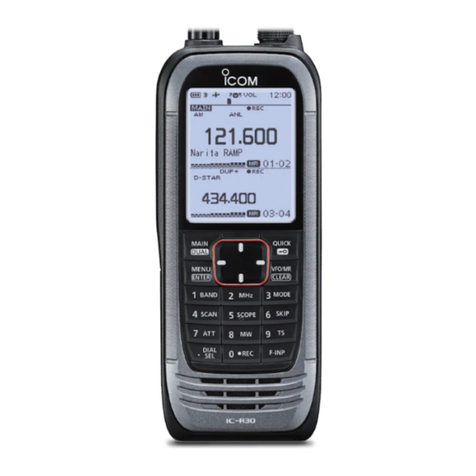
Icom
Icom IC-R30 Setup guide
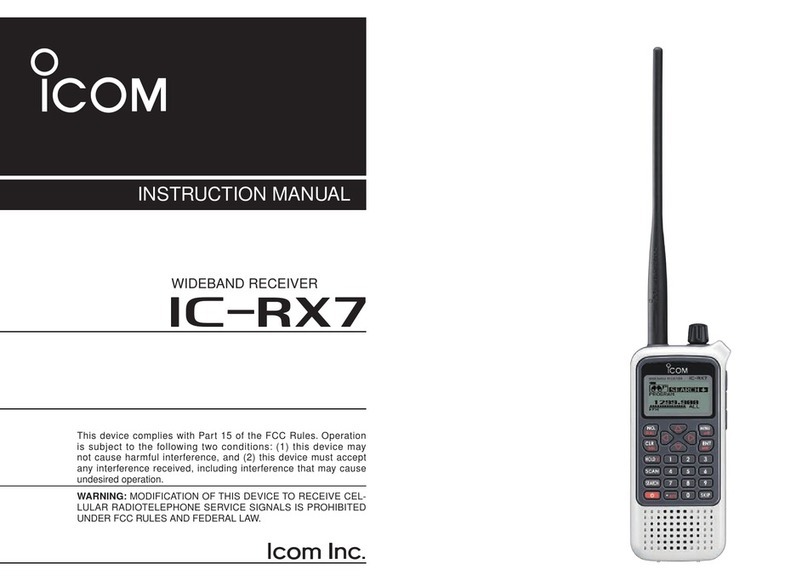
Icom
Icom IC-RX7 User manual
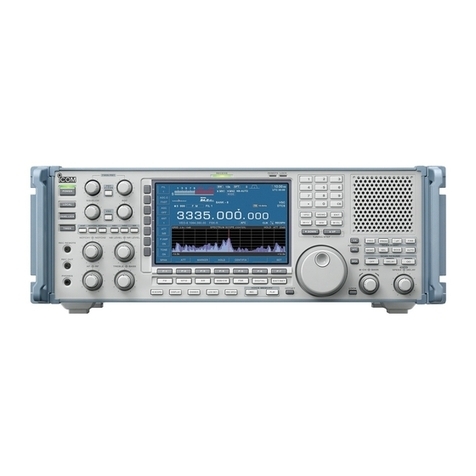
Icom
Icom IC-R9500 Installation and operating instructions
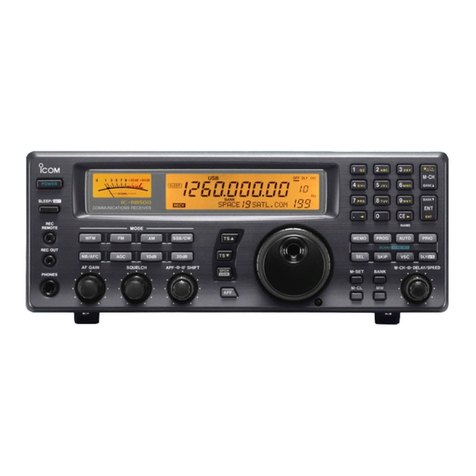
Icom
Icom iC- r8500 Installation and operating instructions

Icom
Icom IC-RX7 Installation and operating instructions
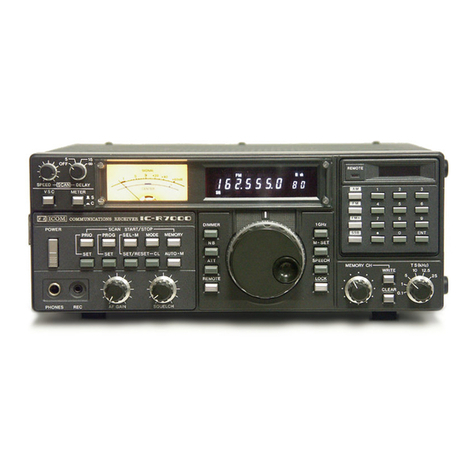
Icom
Icom IC-R7000 User manual
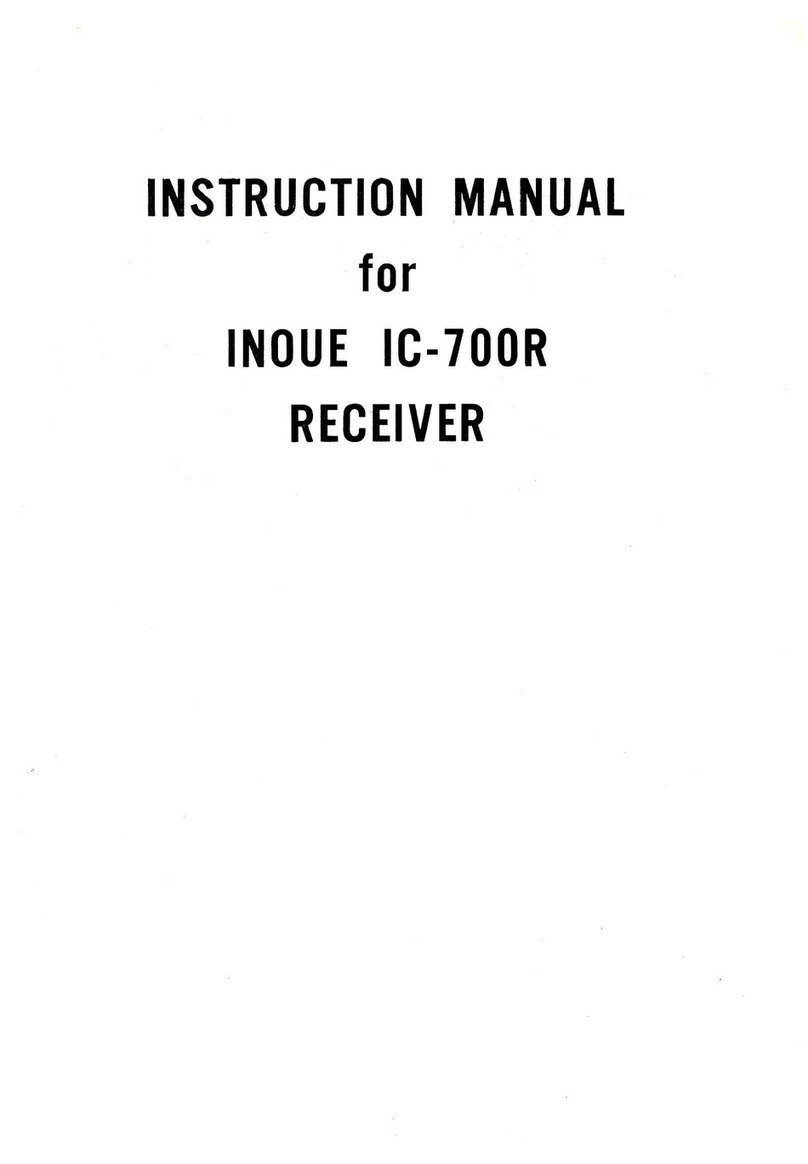
Icom
Icom IC-700R User manual
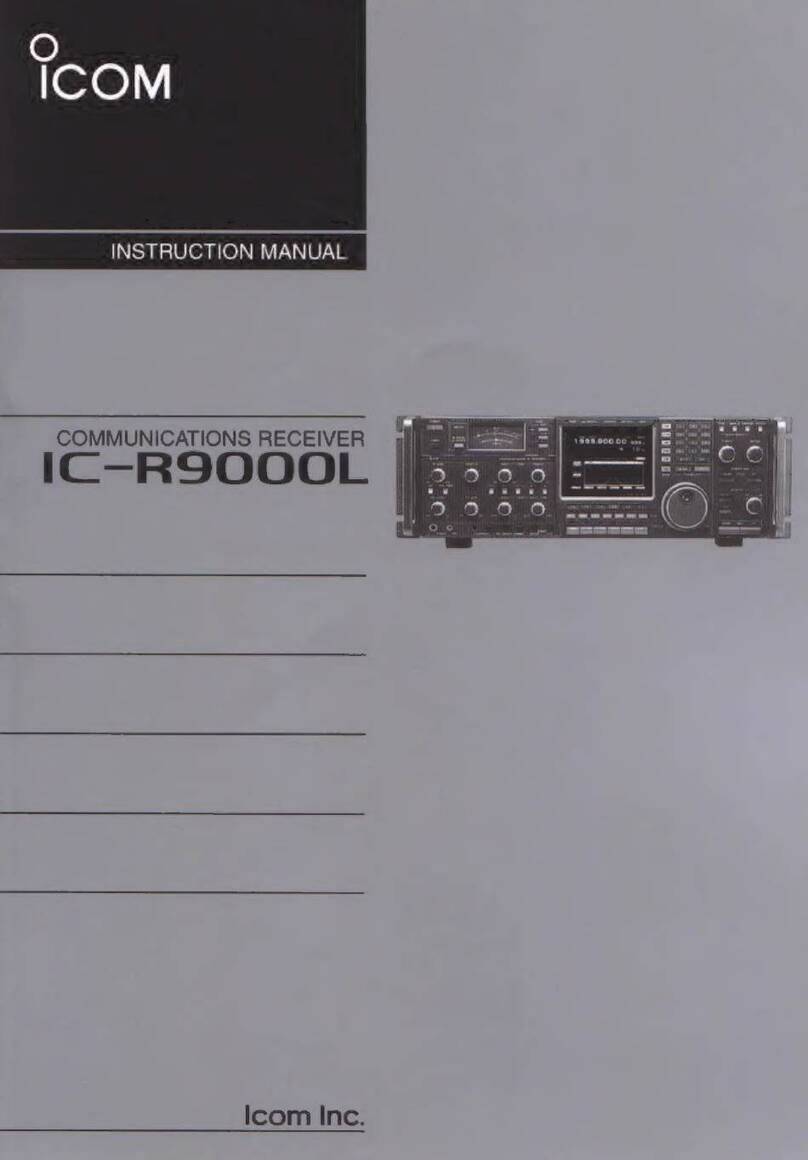
Icom
Icom IC-RSOOCOL User manual
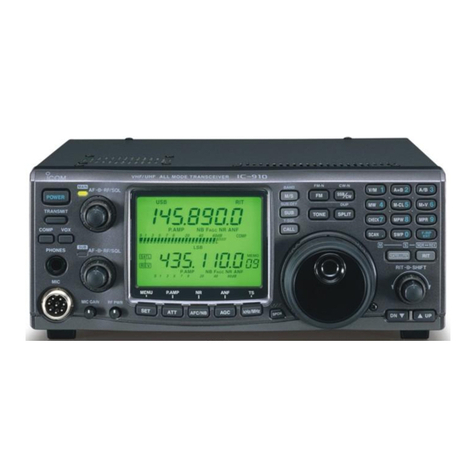
Icom
Icom IC-910H User manual
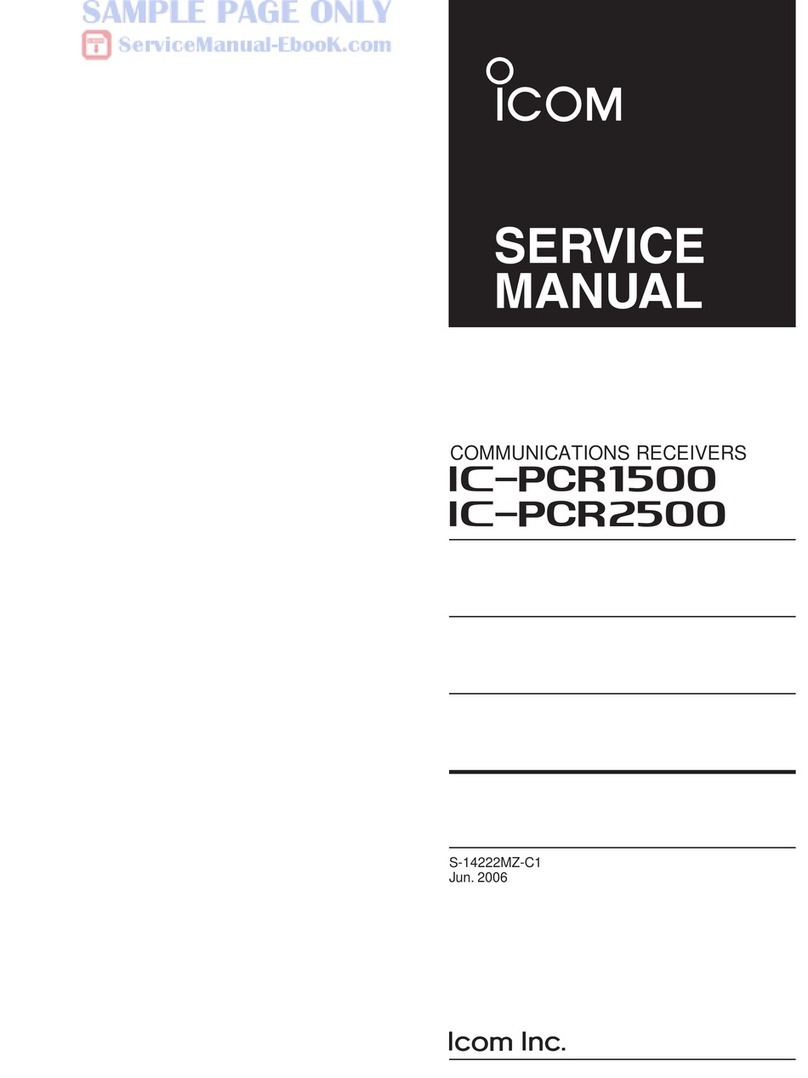
Icom
Icom IC-PCR1500 User manual
